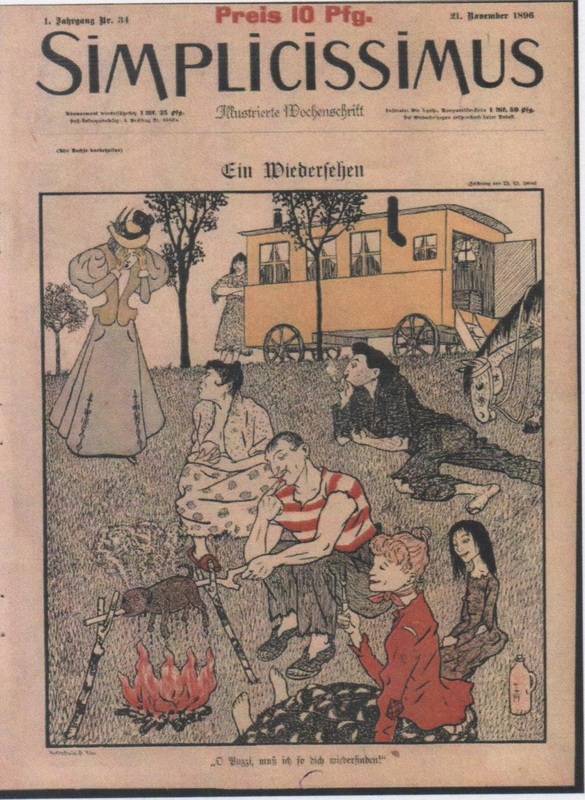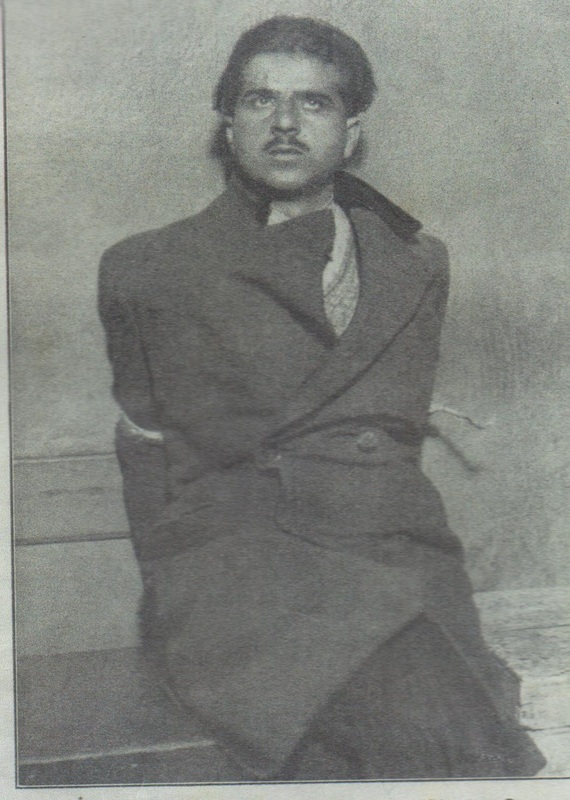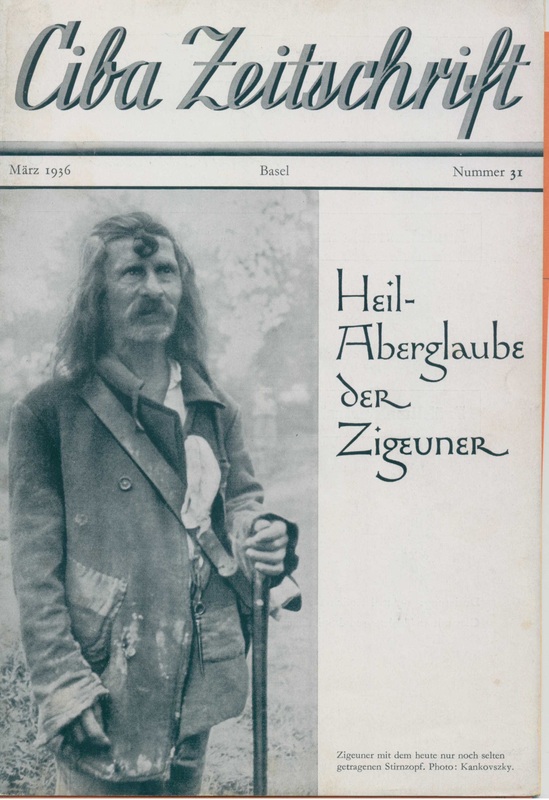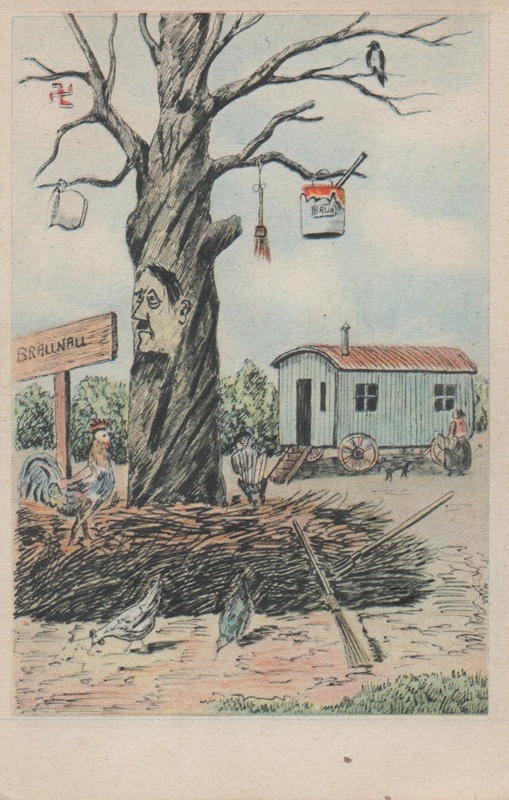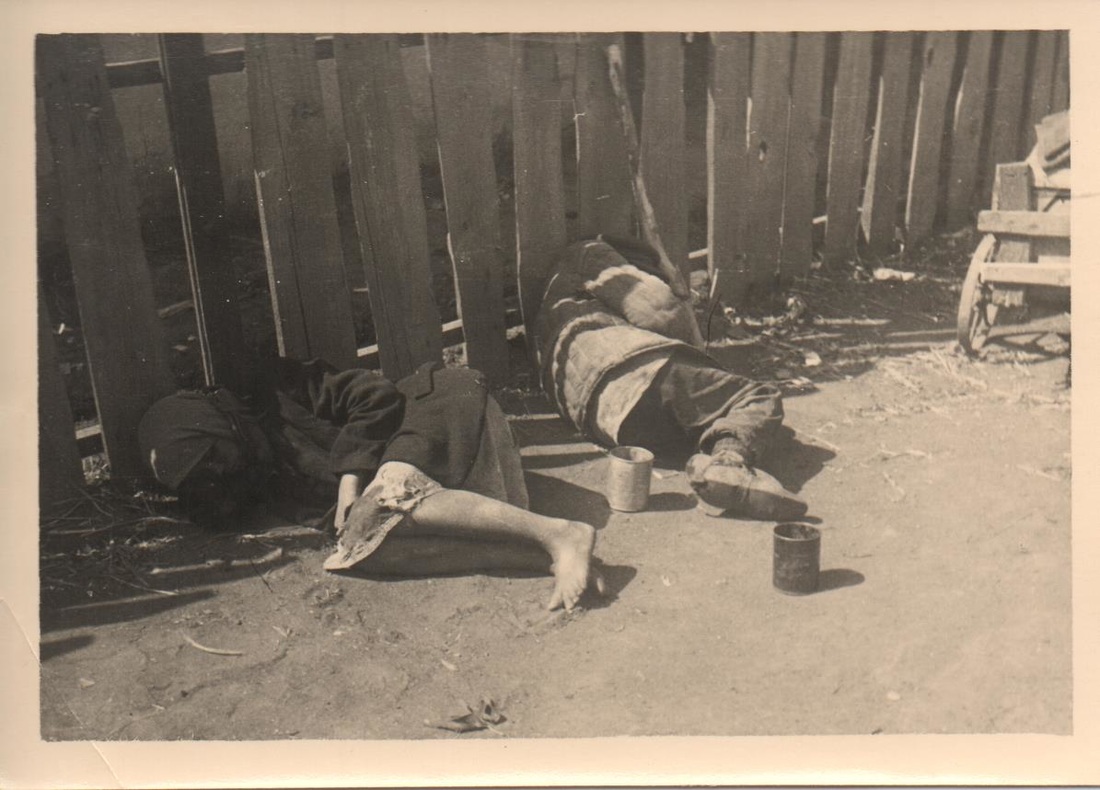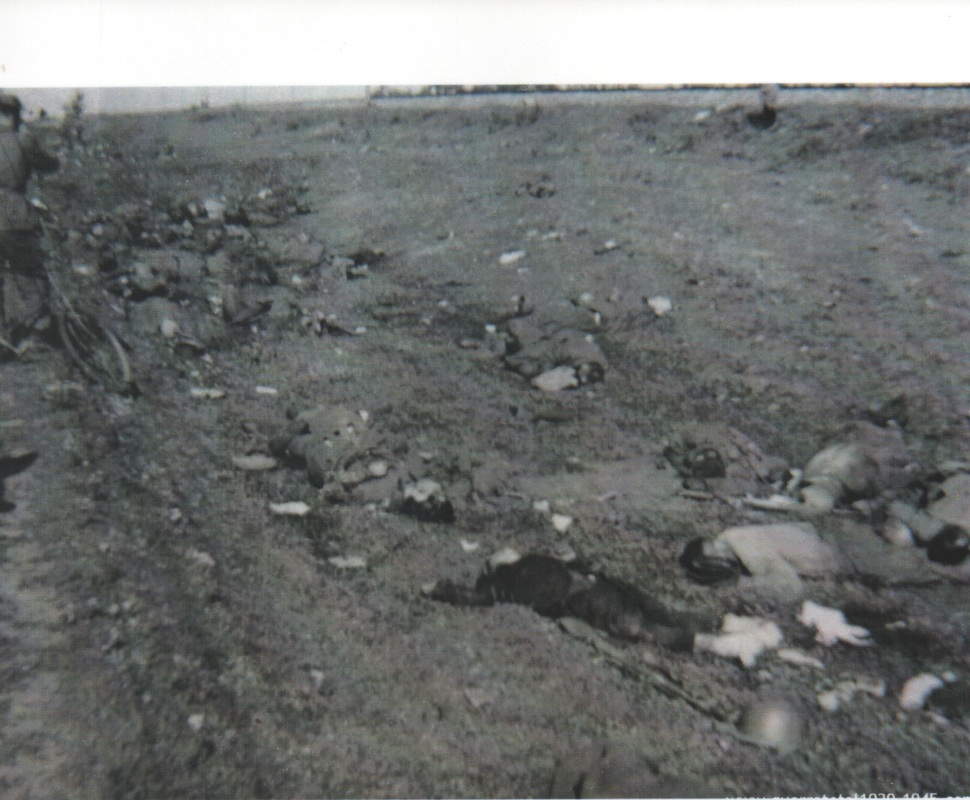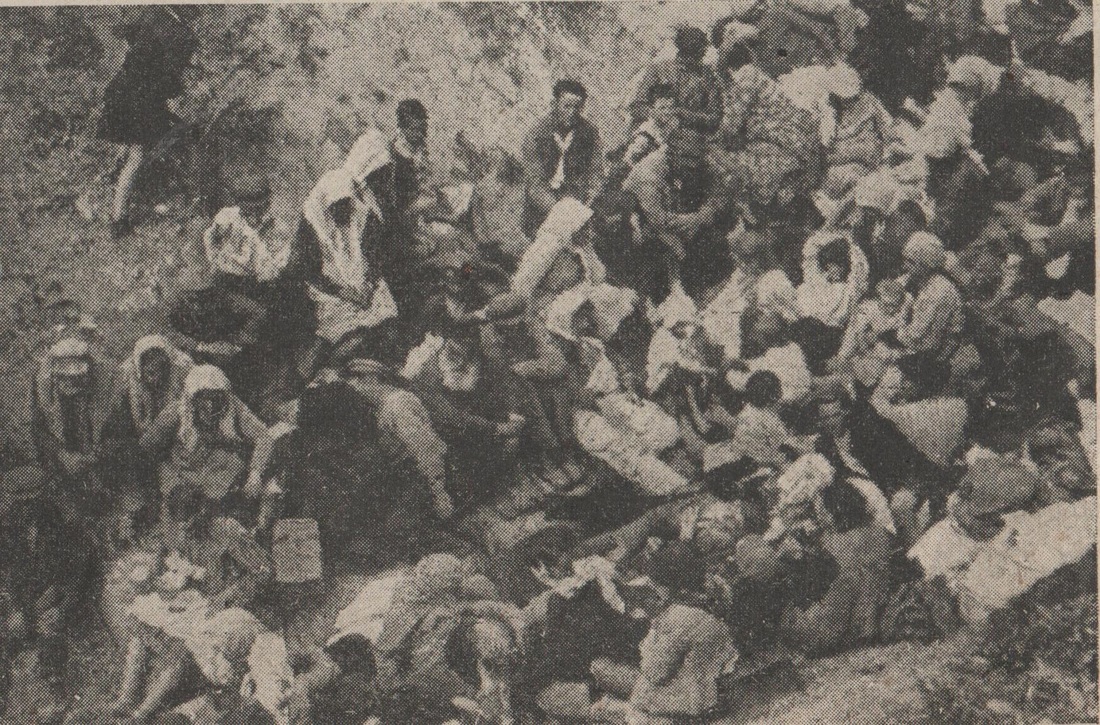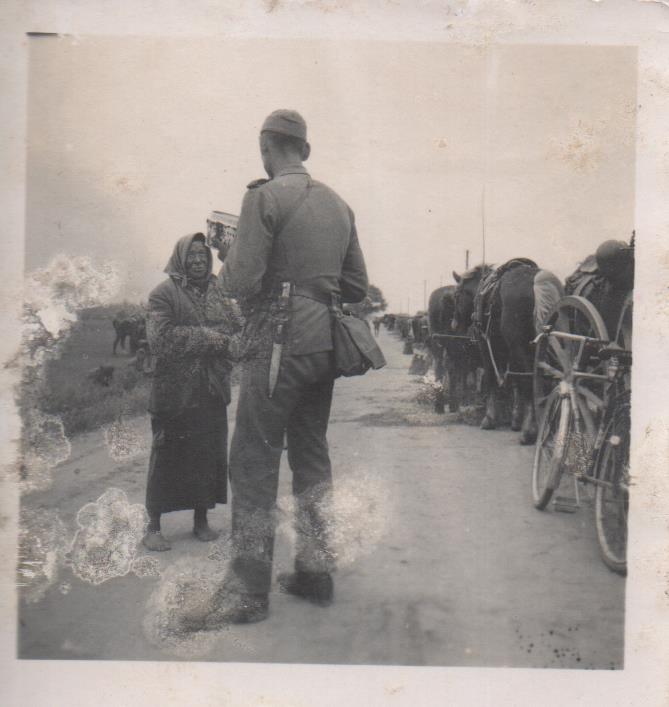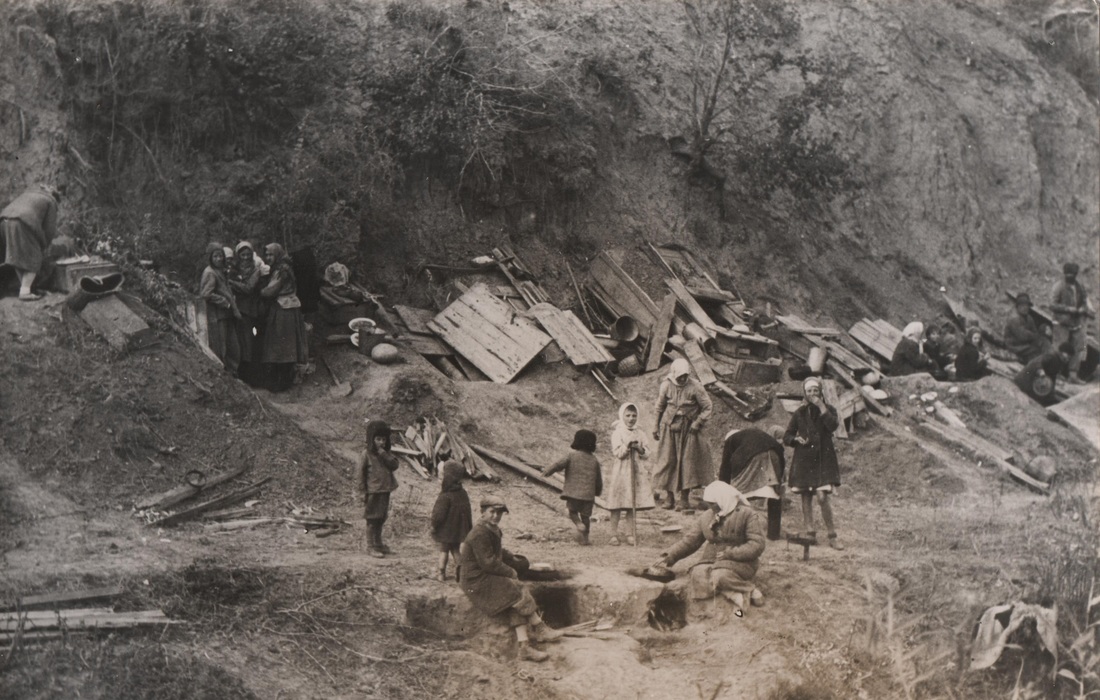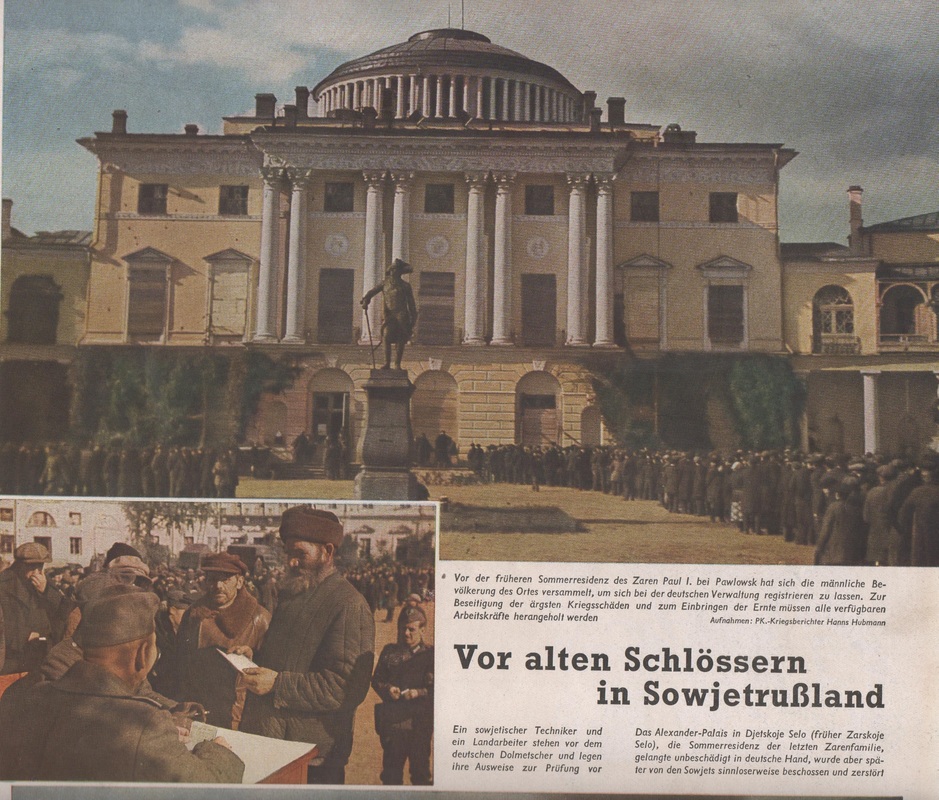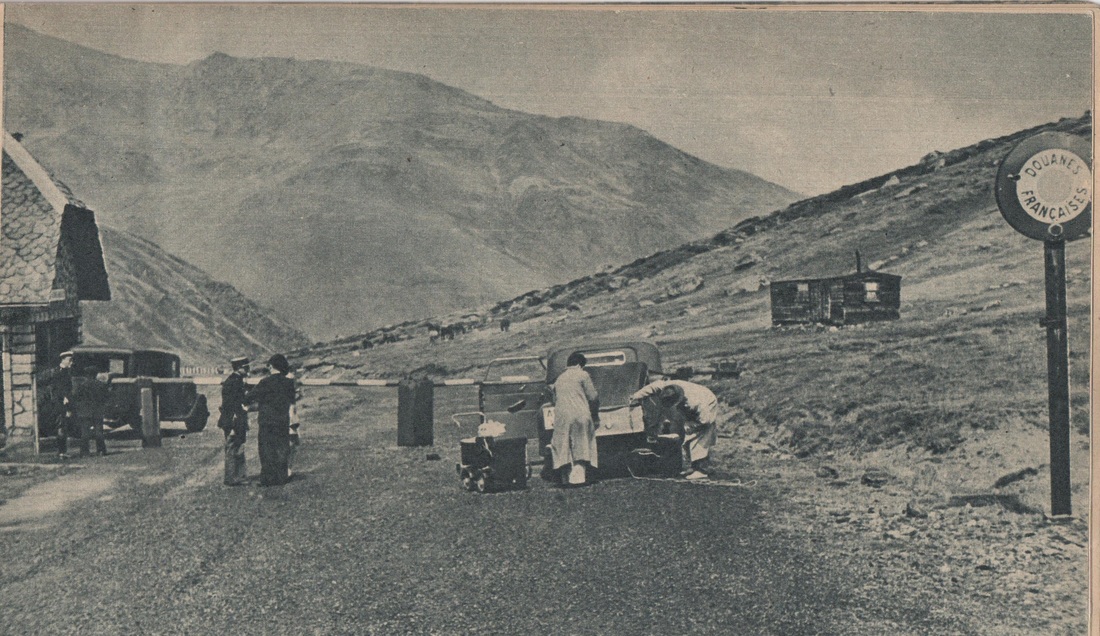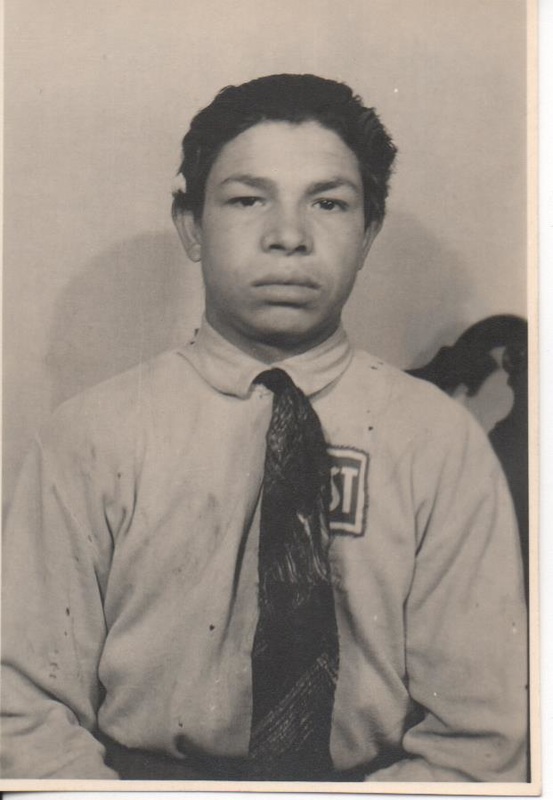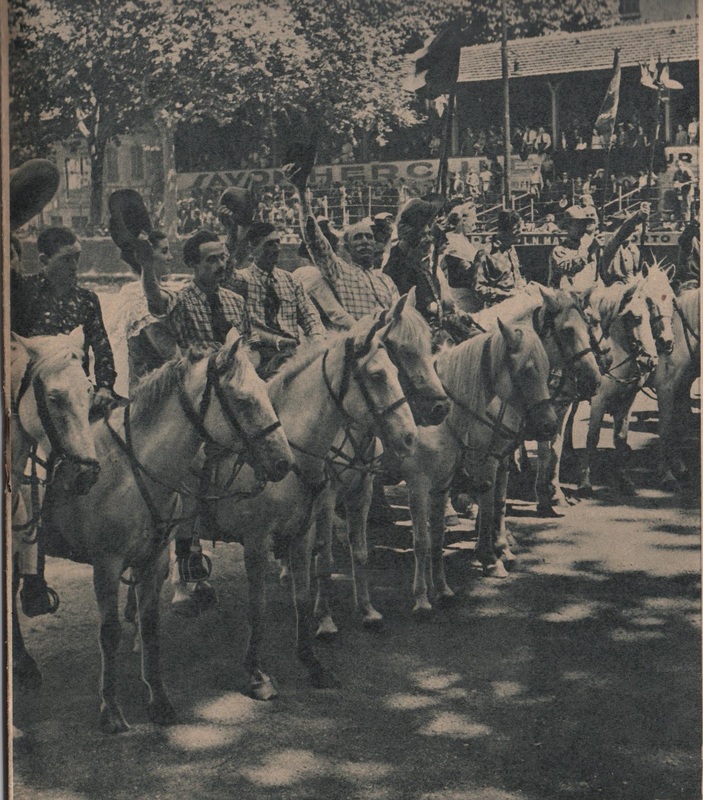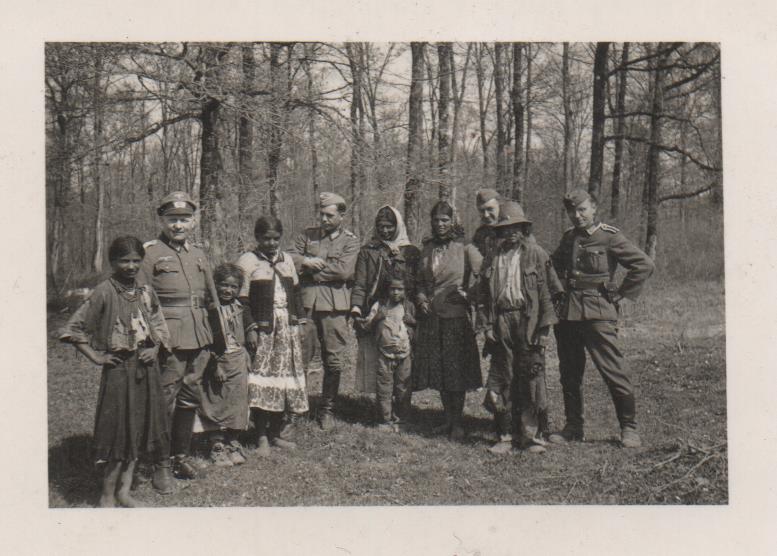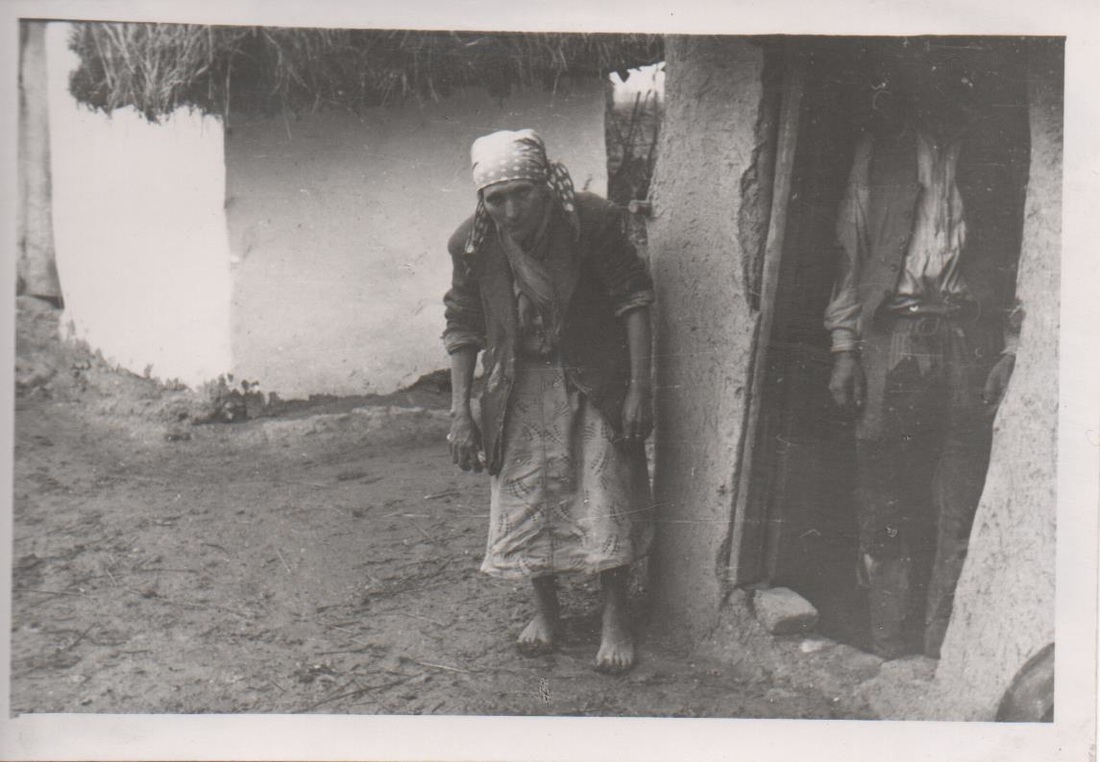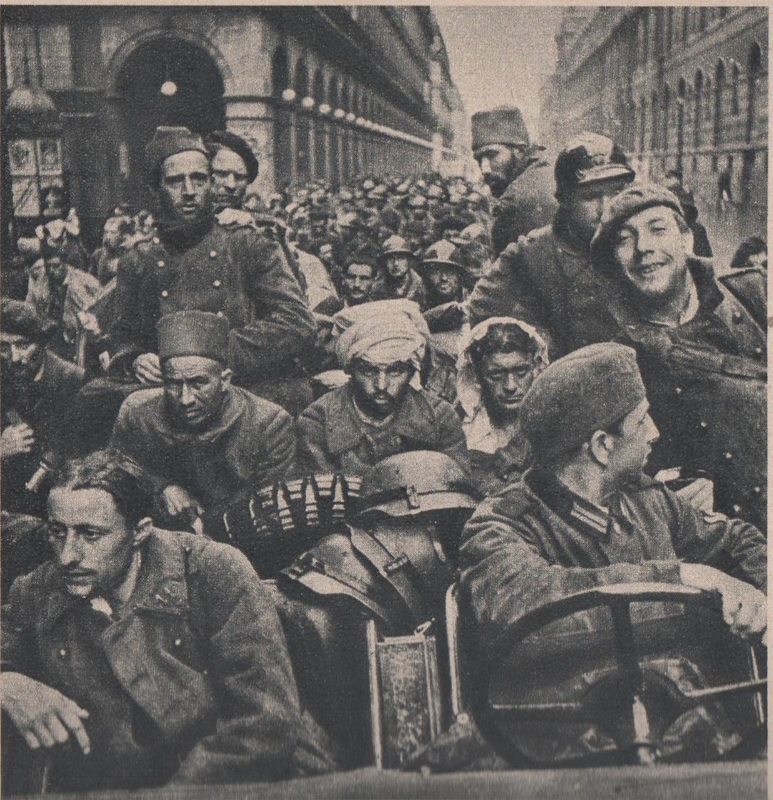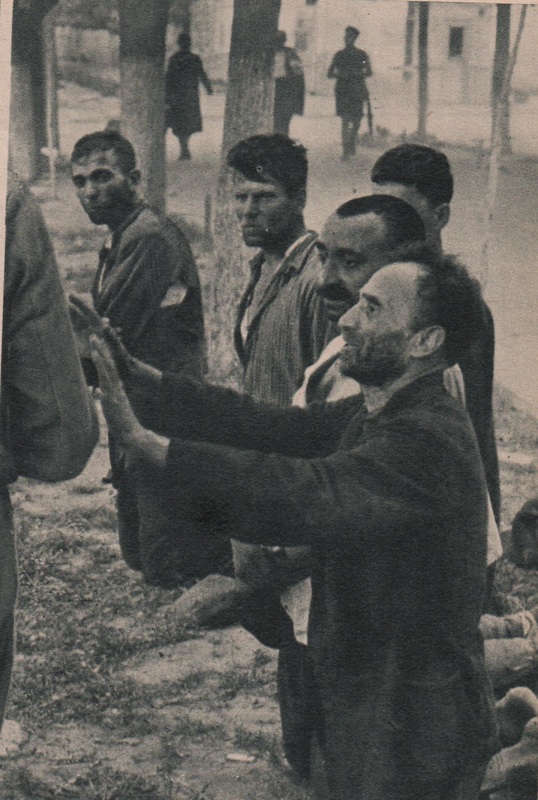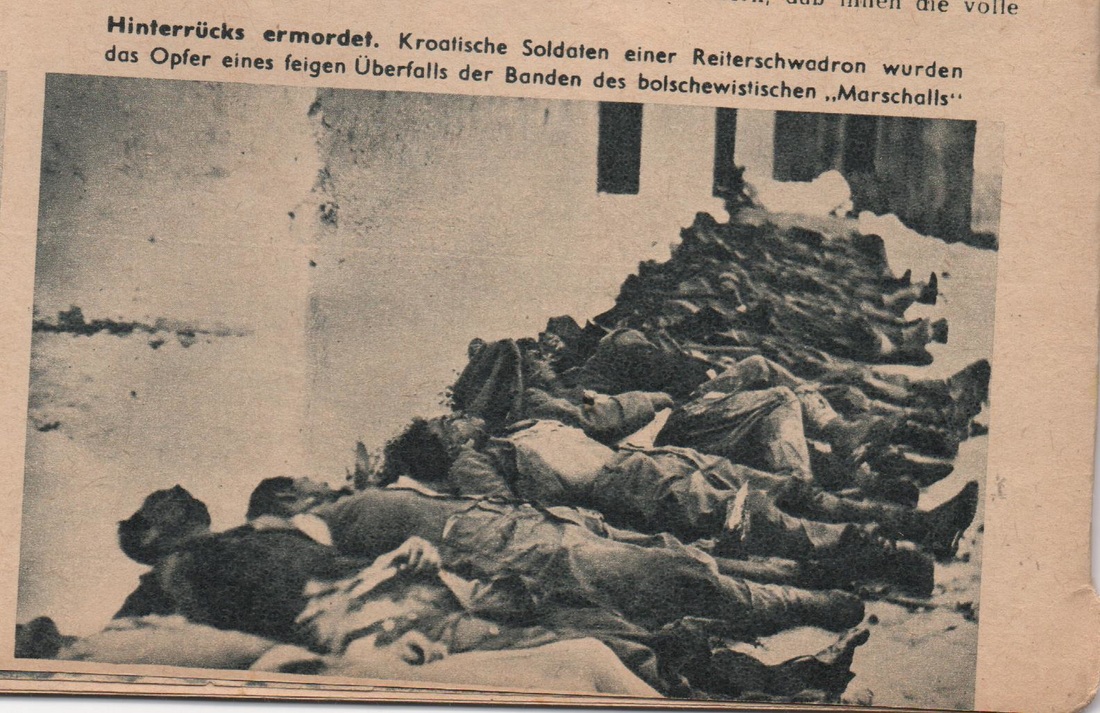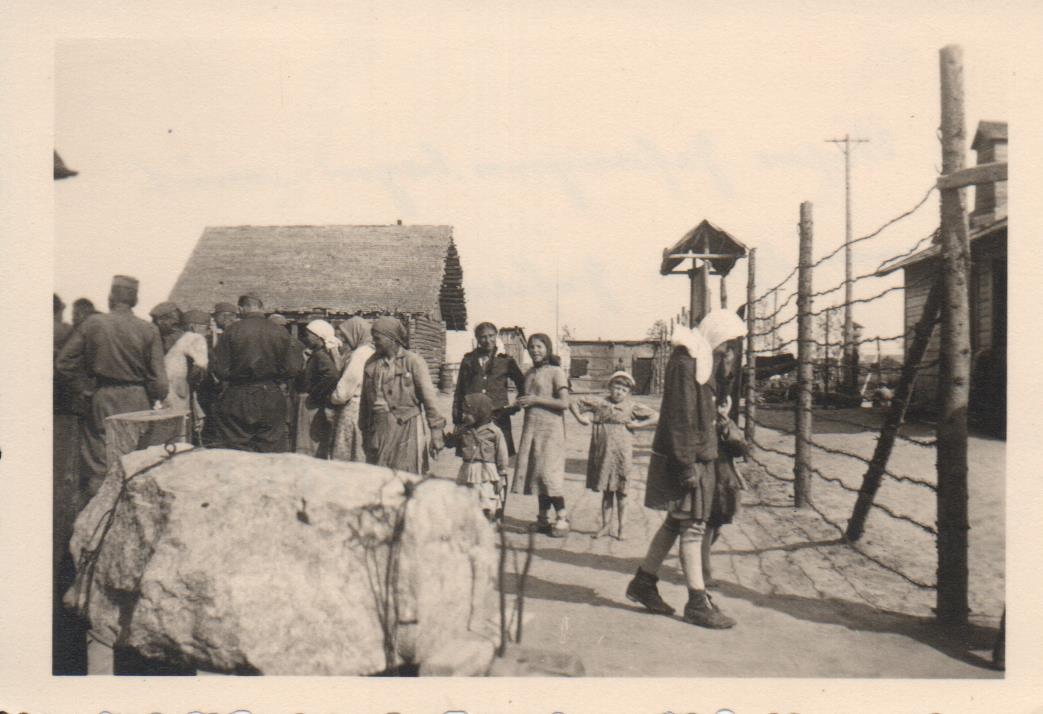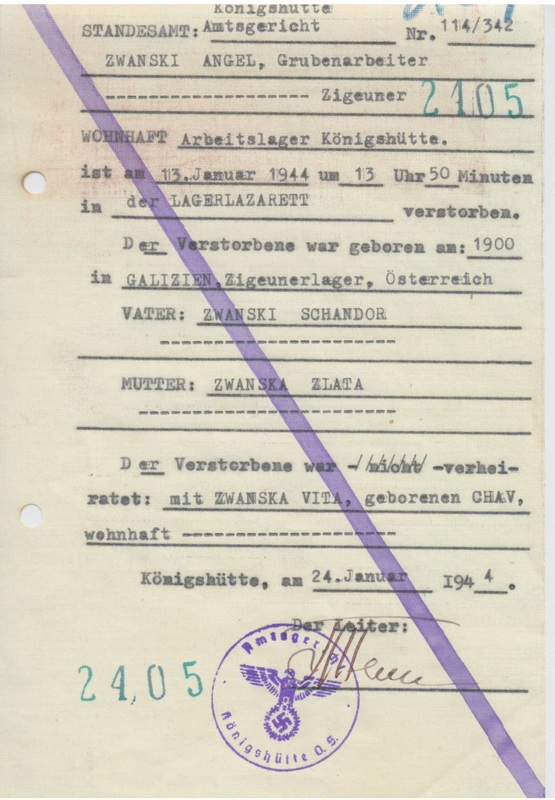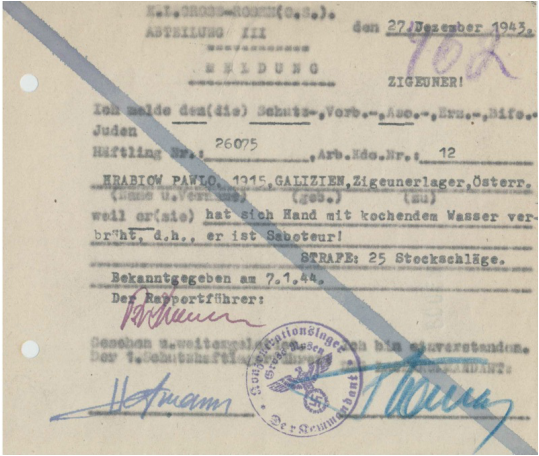In the following, italicised words are by me and not the originals.
This page consists of little known information to do with the Romani Genocide (O Samudaripen). I'm only a gorjer but with 60 years GT contact behind me I feel I have vested interest. It worries me that the Romani genocide is constantly underplayed and Romani suffering played down or forgotten. So often, Romanies are seen as somehow complicit in their own genocide - 'they had it coming/they deserved it' etc, an implication which exists in other Romani respects today to excuse bigotry - like, the Roma are all thieves and come to UK to take our benefits and/or our jobs/ the Doms deserve to be in refugee camps/ send the buggers back etc etc.
Their genocide is so underplayed that, speaking as a friend of lots of wonderful Romanies, I see Romanies as a people with no proper voice who are still the subject of total denial and dislike, not to say hatred. They are denied truth and denied justice in so many ways.
For instance, I recently found an eye witness account by a Jew of gassing of Polish Roma in the gas vans and thought it was new information: I now know that the eye witness is quoted very extensively in many pieces of literature but only one says he witnessed Polish Roma being gassed. All the rest leave one with the impression that it was only Jews (no Roma).
Also, I believe I can prove that the number of Roma/Sinti who died must have been at least 1M. Some sources even only quote the Auschwitz deaths as the total genocide (clearly very very wrong) but Eichmann himself said under interrogation in Israel that he provided transport for 'about 500,000' Gypsies to the death camps from Jan 1943 to the end of the war. But we know vast numbers were killed before that. One of the photos is actually captioned 'Resettling Gypsies in the woods' and dates from early Spring 1941, Yugoslavia. Many more clearly show the beginnings of massacres. Of the first 500 of the photos in my possession to have been carefully examined, 89 show Romanies with German soldiers. Most sources - including me once - classify these as benign encounters only but of these 89 I can now confirm that 50 (56%) definitely show that those soldiers were in SS uniforms and a further 9 (10%) are believed to. It is hard to credit that they are all 'benign'.
More subsequently about Eichmann and his trial but it was a Jewish event in the Jewish homeland with Jewish witnesses to a Jewish horror about the mass murder of Jews so it is not to be wondered that Romanies (and other groups) got little mention. However, he was convicted of crimes against humanity, war crime crimes against Poles, Slovenes and Gypsies.
The following are examples you might not have seen before (pleased bear with me, many are still to go up). There's no good logical way to present them - thematic won't work as there are so many which are across themes. So I'm going to present them in date order as far as possible:
Front cover, Simplicissimus magazine, 21st Nov 1896. Gypsies seen spit roasting a pet dog. Caption reads, 'O Buzzi, I needed you so much - found again.'
Extract from Alfred Rosenberg, Das Besensgesuge des National Sozialismus. First published Munich, 1933 and reprinted 1975 in Beunos Aires for the German community in exile.
Pp19-20
Due to our programme of Jewish hygiene, the Jewish Press is constantly using the argument that the German people’s division of the Jewish people is not racially uniform and the political structure over the racial base is in fact unrealizable, and would only provoke anger between the different ethnic groups, which takes us to conclude that the racial, nationalist idea is anti-popular and anti-state.
To these attempts of deception must be said that there are five racial sub-groups in Europe, each one with its own character, temperament and mental posture but nevertheless it is undebatable that the German nationality does not represent a hybrid mix and undefined, but is based on 80% Germanic. Thus German Nordic Germanism has determined the rhythm of German life, assimilating in many cases other types of blood and of course also experimenting an enrichment of this phenomenon in the individual. But all valuable human beings will find all the characteristic values of Germanic essentially his action, place and cultural element.
What is simply amazing is the phenomenon that goes through millions of people, the auto make-up of the Germanic In boundless fullness is stacking up the work of this great taking of consciousness that goes over the false theory that divides artificially the historic events. That way we don’t start the history of the Germanic-German soul from the year One, but we go back many thousands of years and we draw a straight line from the carriers of the megalithic culture to the like of Widukind and Bismark. And in this great awakening (German) apart from his place of birth, like a fighter succeeding, actively a carrier of values of liberty and the honour of all the Germans. Those who are weak in body and soul are automatically taking apart things through this selective requirement of practical action. This accreditation of Germanic values and his men will reaffirm the victory of the life style of a future Germany.
As one can see, the racial idea is not a destructive element but on the other hand a constructive one. Moreover, it is the last preventative to driving a country ill with penury, fatigue and artificial life of the big cities, that is to say corroded by the Jewish poison to the unity and onwards to the condition of strong state.
That is why National Socialism requires legal separation consecrated by the public right from all African and Asiatic from the German life but that is why it has always demanded the re
Pp19-20
Due to our programme of Jewish hygiene, the Jewish Press is constantly using the argument that the German people’s division of the Jewish people is not racially uniform and the political structure over the racial base is in fact unrealizable, and would only provoke anger between the different ethnic groups, which takes us to conclude that the racial, nationalist idea is anti-popular and anti-state.
To these attempts of deception must be said that there are five racial sub-groups in Europe, each one with its own character, temperament and mental posture but nevertheless it is undebatable that the German nationality does not represent a hybrid mix and undefined, but is based on 80% Germanic. Thus German Nordic Germanism has determined the rhythm of German life, assimilating in many cases other types of blood and of course also experimenting an enrichment of this phenomenon in the individual. But all valuable human beings will find all the characteristic values of Germanic essentially his action, place and cultural element.
What is simply amazing is the phenomenon that goes through millions of people, the auto make-up of the Germanic In boundless fullness is stacking up the work of this great taking of consciousness that goes over the false theory that divides artificially the historic events. That way we don’t start the history of the Germanic-German soul from the year One, but we go back many thousands of years and we draw a straight line from the carriers of the megalithic culture to the like of Widukind and Bismark. And in this great awakening (German) apart from his place of birth, like a fighter succeeding, actively a carrier of values of liberty and the honour of all the Germans. Those who are weak in body and soul are automatically taking apart things through this selective requirement of practical action. This accreditation of Germanic values and his men will reaffirm the victory of the life style of a future Germany.
As one can see, the racial idea is not a destructive element but on the other hand a constructive one. Moreover, it is the last preventative to driving a country ill with penury, fatigue and artificial life of the big cities, that is to say corroded by the Jewish poison to the unity and onwards to the condition of strong state.
That is why National Socialism requires legal separation consecrated by the public right from all African and Asiatic from the German life but that is why it has always demanded the re
The picture below shows:
“Gypsy student Constantinescu who shot the Rumanian Prime Minister G Duca.”
Der Zigeuner Hochschüler Constantinescu , der die rumänische Premierminister G Duca erschossen
I immediately think of the Jew(s) etc who were arrested for the Reichstag fire (Dutch Communist Marinus Van der Lubbe, 1933), the attempt on Hitler and the assassination of the German ambassador in Paris. Communists were blamed for the fire and this allowed the Nazis to act against them though after the War the German and International Communist parties both insisted it had been a deliberate 'false flag‘ operation by the Nazis which they certainly used to arrest/imprison masses of communists and wrest power from them. The attempt on Hitler was by Georg Elser, who was arrested and tortured but refused to name others. He was shot in Dachau just before liberation having been held there for a post-war show trial. Elser was a Christian and Communist – I think there is little doubt that it was not a Nazi propoganda plot but that cannot be totally ruled out. Herschel Grynszpan, a Polish-German Jew, in 1938 shot the German Ambassador in France thus allowing the Nazis the excuse to launch Kristallnacht. His motive was unclear but there is a questionmark over wheteher he even intended to kill the ambassador himself as he only asked to speak to ‚someone‘ at the embassy; there are allegations that it was a homosexual retaliation as well as Jewish retaliation. But the Nazis would say that, wouldn‘t they.
So to Nicolae Constanescu. The only reference to him being Romani that I can find is this simple caption. Notice that the picture shows him bound with rough chord (not rope/handcuffs). He was at the Commerce Academy in Bucharest.
Ion G Duca had not been prime minister long but, a liberal, was hated by right wing organizations for suppressing the ‚military wing‘ of the Rumanian Facsists (the Iron Guard) and banning the political organization itself. He was shot on a railway station in December 1933 by Constanescu accompanied by two others, both Aromanians linked to the Vlach. He was succeeded by an anti liberal and then the right wing/pro Nazi Ion Antonescu.
The three assassins were imprisoned but in 1938 were mysteriously killed whilst being transferred to another prison.
“Gypsy student Constantinescu who shot the Rumanian Prime Minister G Duca.”
Der Zigeuner Hochschüler Constantinescu , der die rumänische Premierminister G Duca erschossen
I immediately think of the Jew(s) etc who were arrested for the Reichstag fire (Dutch Communist Marinus Van der Lubbe, 1933), the attempt on Hitler and the assassination of the German ambassador in Paris. Communists were blamed for the fire and this allowed the Nazis to act against them though after the War the German and International Communist parties both insisted it had been a deliberate 'false flag‘ operation by the Nazis which they certainly used to arrest/imprison masses of communists and wrest power from them. The attempt on Hitler was by Georg Elser, who was arrested and tortured but refused to name others. He was shot in Dachau just before liberation having been held there for a post-war show trial. Elser was a Christian and Communist – I think there is little doubt that it was not a Nazi propoganda plot but that cannot be totally ruled out. Herschel Grynszpan, a Polish-German Jew, in 1938 shot the German Ambassador in France thus allowing the Nazis the excuse to launch Kristallnacht. His motive was unclear but there is a questionmark over wheteher he even intended to kill the ambassador himself as he only asked to speak to ‚someone‘ at the embassy; there are allegations that it was a homosexual retaliation as well as Jewish retaliation. But the Nazis would say that, wouldn‘t they.
So to Nicolae Constanescu. The only reference to him being Romani that I can find is this simple caption. Notice that the picture shows him bound with rough chord (not rope/handcuffs). He was at the Commerce Academy in Bucharest.
Ion G Duca had not been prime minister long but, a liberal, was hated by right wing organizations for suppressing the ‚military wing‘ of the Rumanian Facsists (the Iron Guard) and banning the political organization itself. He was shot on a railway station in December 1933 by Constanescu accompanied by two others, both Aromanians linked to the Vlach. He was succeeded by an anti liberal and then the right wing/pro Nazi Ion Antonescu.
The three assassins were imprisoned but in 1938 were mysteriously killed whilst being transferred to another prison.

In March 1936, the magazine Civa Zeitschrift produced a special issue devoted to 'Zigeuner'. It was intended to be informative, the first article being by the Gypsyologist and GLS member Prof E Pittard. Bearing in mind the Nazi belief that people of Asian descent were 'sub human', the magazine must have provided rich ammunition to supplement Bercovici and Bloch in their anti Gypsy crusades to prove the alleged degenerative nature of Gypsies. The contents were:
Healing superstitions of Gypsies
Gypsy Disease demonology of Transylvania
Hungarian gypsy magical healing methods and disease agents
From healing superstitions of Serbian gypsy
Pregnancy and birth in the zigeunerinn
Disease resistance of Gypsies
Funeral customs of Gypsies
Magical Zoology of Gypsies
The gypsy plait
Drama of the gypsy
Gypsy settlements
tribal organization of the GypsiesGypsy palmistry
Gypsy characters
Letters from readers
The pictures inside show secret signs, voodoo type dolls, voodoo type model figures, amulets to protect from or bring curses and ritual verses. Here's the cover:
Healing superstitions of Gypsies
Gypsy Disease demonology of Transylvania
Hungarian gypsy magical healing methods and disease agents
From healing superstitions of Serbian gypsy
Pregnancy and birth in the zigeunerinn
Disease resistance of Gypsies
Funeral customs of Gypsies
Magical Zoology of Gypsies
The gypsy plait
Drama of the gypsy
Gypsy settlements
tribal organization of the GypsiesGypsy palmistry
Gypsy characters
Letters from readers
The pictures inside show secret signs, voodoo type dolls, voodoo type model figures, amulets to protect from or bring curses and ritual verses. Here's the cover:
Below is a postcard produced in Alsace in the mid or late 1930s. It translates as 'Hitler's family tree'. The implication is that Hitler is of Romani descent - it is well documented that claims were made that he was of Jewish descent (but little or no evidence) and this implies that he was descended from a Romani family. In time, I shall be adding information from the Eichmann trial and the Wanassee conference which bear on this claim, but for which there is no genealogical evidence that I can find.
The picture below is from the massacre at Bromberg, Poland, and shows ‘two dead Gypsies’ killed by Einsatzgruppe 4b, as identified on the back of the photo. Under magnification, a patch of blood can be seen on the woman’s dress. Retreating Polish soldiers killed hundreds of German-origin people in the town so when 4b arrived, they took revenge on 3rd September 1939 by massacring hundreds of Jews, Gypsies and Poles. It was also Einsatzgruppe 4 which was involved in the Babi Yar murders and which achieved particularly high numbers of Gypsy killings.
Ohlendorf, one of the Einsatzkommando leaders, specifically ordered that Gypsy children should also be killed "as the killing was not intended to be a temporary solution but was to lead to a permanent solution. As children of parents who had been killed they represented no lesser danger for the Germans than the parents (Zimmerman in Kenrick:133)."
Ohlendorf, one of the Einsatzkommando leaders, specifically ordered that Gypsy children should also be killed "as the killing was not intended to be a temporary solution but was to lead to a permanent solution. As children of parents who had been killed they represented no lesser danger for the Germans than the parents (Zimmerman in Kenrick:133)."
The Einsatzgruppen
Though every Einsatzgruppen - A, B, C and D - were involved in the murder of Gypsies, the reputation of Groups B and D in the murders were particularly horrific. Though there were far more Jews than Gypsies, on some occasions more Gypsies were murdered at particular locations than Jews such as at Mogileb (Belarus). Murders in Yugoslavia are particularly under reported but were clearly massive - evidence to follow. Source: Javier Gomez Perez, The Einsatzgrupen, Battalions of Death, 2014. Below left, murdered Gypsies. Below right, a very interesting photo. It was published in the Nazi Signal magazine in June 1941 and purports to show refugees from the Russians; On 25th July it appeared in a US magazine (no title) stating that they were rounded up and put there by Nazis. Several Roma visible. As stated, more is to follow on Einsatzgruppen (eg trials) but the following lesser known officers were heavily involved in Gypsy murders in Yugoslavia and Rumania:
Standartenfuhrer (= Colonel) Wilhelm Fuchs
Grupenfuhrer (= Major General) August Meyszner
Obersturmfuhrer (= Lieutenant Colonel) Ludwig Teichmann
Standartenfuhrer (= Colonel) Gunther Hermann
Fuchs was involved in both Yugoslavia and Rumania.
Though every Einsatzgruppen - A, B, C and D - were involved in the murder of Gypsies, the reputation of Groups B and D in the murders were particularly horrific. Though there were far more Jews than Gypsies, on some occasions more Gypsies were murdered at particular locations than Jews such as at Mogileb (Belarus). Murders in Yugoslavia are particularly under reported but were clearly massive - evidence to follow. Source: Javier Gomez Perez, The Einsatzgrupen, Battalions of Death, 2014. Below left, murdered Gypsies. Below right, a very interesting photo. It was published in the Nazi Signal magazine in June 1941 and purports to show refugees from the Russians; On 25th July it appeared in a US magazine (no title) stating that they were rounded up and put there by Nazis. Several Roma visible. As stated, more is to follow on Einsatzgruppen (eg trials) but the following lesser known officers were heavily involved in Gypsy murders in Yugoslavia and Rumania:
Standartenfuhrer (= Colonel) Wilhelm Fuchs
Grupenfuhrer (= Major General) August Meyszner
Obersturmfuhrer (= Lieutenant Colonel) Ludwig Teichmann
Standartenfuhrer (= Colonel) Gunther Hermann
Fuchs was involved in both Yugoslavia and Rumania.
Below, left, photo with, on the back, "Gypsies being dealt with" (location and year not stated). Below, right, "Gypsies and peasants picking through the ruins, Stalingrad." This photo was taken by a French soldier serving with the Wehrmacht. It later came into the possession of a news agency who circulated it widely.
Below left, registering civilians at Detskoje Selo, Russia, December 1943 (Signal Magazine); below right, Romani wagons abandoned on the Spanish/Andorran border (Signal magazine, 1st August 1943). Not clear which side of the border.
Below, left, Ukrainian Gypsy wearing Ost slave badge. Below right, clean cut Gypsies in the Camargue, photo appearing in Nazi Signal magazine, July 1940, to illustrate what proper Gypsies looked like. More pictures will be going up from this magazine. The Nazis had earlier produced a book of photos showing racial types so it was allegedly possible to identify the sub-human peoples from the pictures to ensure the Einstatzgruppen killed the right ones. Such was the theory. Interestingly, black people are shown waving spears and firing bows and arrows and 'pure Aryan' are shown naked! More to come!
Below, two very important pictures relating the actions of the Einsatzgruppen in Yugoslavia. Very few 'academics' refer to these massacres which should be very much better known. In the German soldier's photo album, the first picture is titled 'Gypsies being resettled in the woods.' On the back it states, 'On the way to Agram (=Zagreb), 13.4, nalk loaded.' It took me a long time to discover what 'nalk' meant - it is soldier's slang for a machine gun mounted on a motorcycle combination. The year will be 1941 and at the end of April 1941, Jews from Zagreb were taken into the same woods to the murdered. So the Gypsy one is a 'dress rehearsal'. Notice the obligatory (from a Romani point of view) chaperone who would have had no chance whatsoever. Then the question is, why have they picked pretty young women and girls to be photographed? The officer in the picture looks like Kurt Daluege whose boss, Standartenfuhrer Wilhelm Fuchs, was in charge of the Serbian Einsatzgruppe. Daluege's claim to fame was the destruction of Lidice and the murder of its inhabitants in retribution for the assassination of Heydrich. At least one of the soldiers is SS. The second picture from a different soldier is simply titled 'Gypsy transgression, Croatia'.
Below left, non Aryan people being taken to camps via the Rue de Rivoli, Paris; below right, "Commissars, Jews and Gypsies pleading for their lives, Russia". Another can be seen being escorted there in the background. Appeared in the Nazi Signal magazine, 1st September 1941. Below these, massacre of Croations allegedly by Communists, 1944.
The Wannsee Conference and Gypsies
On 20 January 1942, a conference, chaired by Heydrich assisted by Eichmann, was held at the Wannseee Villa with key Nazi officials present to decide the fate of the Jews.
That is the received wisdom of the conference. It was in fact much more. Another received wisdom is that Gypsies were never mentioned. When researchers claim that they were not mentioned, there comes the implication that Gypsies were not significant or even not involved and so there is no need to mention them. They were mentioned and so0me of those references are very significant.
A stenographer recorded a detailed account of the conference but Heydrich demanded summarized minutes which he heavily edited and that is all that has survived as evidence (Rosemann, p 70).
I have researched several sources, the first being Mark Rosemann, The Wannsee Conference and the Final Solution, London, Folio Society, 2012. The following is entirely from this source. More information from other sources (including other Romani references) is to be added.
The conference is usually now seen as a confirmation of policies already decided. The assumption that it launched ‘the Final Solution’ is wrong because massacres of Jews and Gypsies were already occurring in the woods and fields. (P 4)
The deportation of 60,000 Jews to the Lodz ghetto, reduced after protests to 25,000 Jews and Gypsies with the intention of their being moved subsequently to the General Government territory, was mentioned. As a result of the protests, it was agreed that Jews and Gypsies from the Czech Potectorate should be directly sent to the Soviet Union. The remainder of the 60,000 were sent to camps at Minsk, Kovno and Riga along with some more (p 44 and 53).
The conference heard and accepted that there was a need to eliminate ‘useless eaters’ and ‘the most burdensome’ first. Able bodied people would be used for heavy labour and worked to death, the rest ‘eliminated’ (p31 and 51).
The Einsatzgruppen were reported to be active (p32), first with Jews in leading positions, then to military aged Jews, then to all (p32-33). However, I can prove that Gypsies were being used as ‘dress rehearsals’ in the murders and this evidence is to follow.
The conference concurred with Wilhelm Stuckart’s view that Jews were ‘lesser quality than other human being and therefore extermination was justified" (p 92. ) This is important from a Gypsy point of view because it becomes apparent - evidence to follow - that Gypsies were by now being lumped in with Jews.
On 20 January 1942, a conference, chaired by Heydrich assisted by Eichmann, was held at the Wannseee Villa with key Nazi officials present to decide the fate of the Jews.
That is the received wisdom of the conference. It was in fact much more. Another received wisdom is that Gypsies were never mentioned. When researchers claim that they were not mentioned, there comes the implication that Gypsies were not significant or even not involved and so there is no need to mention them. They were mentioned and so0me of those references are very significant.
A stenographer recorded a detailed account of the conference but Heydrich demanded summarized minutes which he heavily edited and that is all that has survived as evidence (Rosemann, p 70).
I have researched several sources, the first being Mark Rosemann, The Wannsee Conference and the Final Solution, London, Folio Society, 2012. The following is entirely from this source. More information from other sources (including other Romani references) is to be added.
The conference is usually now seen as a confirmation of policies already decided. The assumption that it launched ‘the Final Solution’ is wrong because massacres of Jews and Gypsies were already occurring in the woods and fields. (P 4)
The deportation of 60,000 Jews to the Lodz ghetto, reduced after protests to 25,000 Jews and Gypsies with the intention of their being moved subsequently to the General Government territory, was mentioned. As a result of the protests, it was agreed that Jews and Gypsies from the Czech Potectorate should be directly sent to the Soviet Union. The remainder of the 60,000 were sent to camps at Minsk, Kovno and Riga along with some more (p 44 and 53).
The conference heard and accepted that there was a need to eliminate ‘useless eaters’ and ‘the most burdensome’ first. Able bodied people would be used for heavy labour and worked to death, the rest ‘eliminated’ (p31 and 51).
The Einsatzgruppen were reported to be active (p32), first with Jews in leading positions, then to military aged Jews, then to all (p32-33). However, I can prove that Gypsies were being used as ‘dress rehearsals’ in the murders and this evidence is to follow.
The conference concurred with Wilhelm Stuckart’s view that Jews were ‘lesser quality than other human being and therefore extermination was justified" (p 92. ) This is important from a Gypsy point of view because it becomes apparent - evidence to follow - that Gypsies were by now being lumped in with Jews.
Below, Olunin Concentration camp, Poland, 1942, where people with mental health problems (including Gypsies) were imprisoned before being murdered. I have found a second specific Gypsy murder camp in Russia - details to come - and I suspect there must be more.
Hannah Arendt: Eichmann in Jerusalem: A Report on the Banality of Evil. New York, Penguin, 2006.
This book gives background, information about Eichmann’s interrogation in Jerusalem, and his trial.
Most of the reports of these matters make few (if any) references to Gypsies but in fact there were some very important mentions.
When it came to the judgements, one charge cited crimes against humanity of Gypsies but a second count (11) referred to deportation (only) of Gypsies because it could not be proved that Eichmann knew their fate (pp243-4) though Eichmann had actually said under interrogation that he knew the fate of the Gypsies. When asked why they had to die, he said he did not know but thought it had come from Himmler and that there had been no research done on the cultural side of Gypsies (p245) but that he had no doubt they were being exterminated. Unfiortunately, Arendt’s account makes a serious omission. In the oral transcript of the interrogation, Eichmann states that between January 1943 and the end of the war he had provided transport for ‘about 500,000 Gypsies’.
At meetings in September 1939 and January 1940, at which Eichgmann was present, it was decided that the middle strata of the Polish intelligentsia – ie, teachers, clergy, nobility, legionaries, returning officers etc’ should be arrested; primitive Poles were to be used as migratory labour; Jews were to be assembled into centres to be sent East later; all Gypsies in Silesia (30,000) had to be sent immediately by train Eastwards and Eichmann was to conduct the evacuation.
In Autumn 1941, the army was plagued by partisan activity in the Serbian part of Yugoslavia and the military authorities decided to solve two problems at once by shooting a hundred Gypsies and Jews for every German soldier killed, even though the victims were not in fact partisans. These people were already in camps so there was easy access. However, the local military command wanted to make it clear that they could deal with partisans without hostages so instead, began deporting Jews and Gypsies to solve one half of the problem. This was without authority: Eichmann was informed but it was Luther of the Foreign Office who reminded General Bohme that in Russia they had dealt with considerable numbers of Jews and Gypsies without the military commanders there even bothering to report the matter and therefore Bohme was ordered to deal with the matter in similar fashion (p23). Bohme did, and in August 1942, Staatsrat Harald Turner, head of the civilian branch of the military government, announced that “Serbia is the only country in which the problems of both the Jews and the Gypsies have been solved (p184) and he therefore returned the gas vans he had been using.
Until November 1941, the partial responsibility held by Otto Thierack, Minister of Justice for ‘Poles, Russians, Jews and Gypsies’ was passed over to Himmler (p158).
It was in September 1941 that Eichmann, by his own initiative and without an order to do so, sent 5000 Gypsies from the Rhineland to Lodz ghetto. Why is unclear but it may have been because the man in charge of the ghetto, Uebelhor, was not shifting Jews as he should as he was making good profit from their being there. Uebelhor complained to Himmler that Eichmann and his men ‘had deceived me with horsetrading tricks learned from the Gypsies (p94).’ Himmler and Heydrich protected Eichmann from the complaint.
One of the features which emerged in the trial was evidence about Wilhelm Kube, General Commissioner for Occupied Russia, who was outraged when Eichmann sent him German Jews with the Iron Cross who he described as ‘people from our own cultural milieu’ and, importantly, has led (says Arendt) “among Germans today a stubborn misinformation to the effect that only Ostjuden, Eastern European Jews, were massacred,” and thus (a question posed by Prof Salo W Baron), that the death of the Jews would have been less of an evil if they had been a people without a culture, such as the Gypsies who were also exterminated (p96).” The attorney general, Hausner, thought the answer to this was yes. So here we have an extension of the Gypsies-had-it-coming argument.
One of Eichmann’s defences against conscience and his lack of it was that one had a different personal attitude to death when it was all around. Eichmann described the existence of a dual extermination programme in autumn 1941, justifying the Einsatzgruppen murders as the work of tackling partisan warfare which included Gypsies, communist functionaries, the asocial, the insane and Jews (p106).
It is well known that the Bulgarian administration managed to protect a large number of their Jews and Gypsies and in June 1943, the German ambassador in Sofia (Adolk Beckerle) reported to the Foreign Office that the situation was hopeless ‘because the Bulgarians have lived too long with peoples like Armenians, Greeks and Gypsies to appreciate the Jewish problem (p188)’.
Eichmann
David Cesarani, Eichmann: His Life and Crimes, London, Vintage Books (Random House) 2004.
Eichmann’s trial in Jerusalem is often quoted but few Gypsy reference ever occur. Naturally it was a massively Jewish event. Far more significant from a Gypsy point of view was his interrogation.
“Paradoxically, the Jews were not the only or even the primary targets of his race-based callousness.” (Cesarani, p15)
After the Wannsee conference, it was Eichmann who Heydrich ordered to ‘tidy up-‘ the minutes before he put his finishing touches to them and over brandy and cigars he explained what he wanted leaving in and taken out especially in the area of methods of killing (Cesarani, p114).
Cesarani’s book is one of those annoying ones which make no reference to Roma and Sinti in the index but they occur many times during the text.
At Eichmann’s trial, Count 11 at the trial covered the concentration and deportation of tens of thousands of Gypsies whilst other charges related to deportation under inhumane conditions of 500,000 Polish civilians with the intention of resettling Germans in their homes, the deportation of 14,000 Slovenes, and the deportation of 100 children from Lidice to Poland where they were apparently murdered (Cesarani p 253).
Earl’s account of the Nuremberg SS Einsatzgruppen Trial
Earl, Hilary, The Nuremberg SS-Einsatzgruppen Trial, 1945-1958. Cambridge, Cambridge University Press, 2009.
In 1947, 27 leaders of the SS Einsatzgruppen murder squads went on trial.
Earl’s account of the trials contain several references to Romanies.
Summary: Gypsies were killed on Hitler's orders, not as asocials but for racial reasons ('racial hygiene'.)
After the Einsatzgruppen entered Russia on June 22nd, 1941, they limited their action to communist functionaries, Jewish men, all Gypsies and, occasionally, the inform (p5). By July 1941, 100,000 people a month were being shot and this continued until July 1942 (p6).
In preparing for the trial, the prosecution used actual Einsatzgruppen reports to ascertain who was responsible for which murders and from this compiled lists of the numbers of Jews, Gypsies, the mentally ill and partisans who were murdered (p82). Apart from ‘obeying orders’, a common defence by the defendants, most stated that the orders came direct from Hitler and therefore they simply obeyed. In addition, Martin Sandberger, (who had a doctorate degree in law, was a Standartenfuhrer, commander of Sonderkommnando 1a, commander of Sicherheitspolizei and SD in Estonia) had an additional defence, that those who were killed were thoroughly investigated and had a fair trial first and were executed as communist functionaries and therefore security risks. He claimed those found guilty could appeal. The court decided that his reports from the murders were deliberately falsified to make it look as though they did not kill many but the esteem in which he was held in Berlin shows this was untrue (p159). Gustav Nosske totally denied killing Jews and Gypsies or other members of racially inferior minorities in his Einsatzkommando even though his superior officer, Gruppenfuhrer Otto Ohlendorf (who had degrees in law and economics), had already stated to the court that they did (p161).
Adolf Ott said he took no part in killing as it had all been done before he arrived in Russia; most of the defendants said that if had they not done the killing, someone else would have ( p209). All justified the killings as Fuhrerbefehl, that is, by direct order from Hitler (p146-7, 158-9, 210-11) and specifically Jews, Gypsies and Soviet officials. (p211). When the prisoners were found guilty of the crimes against humanity, specifically naming Jews, Gypsies and Communist functionaries, the Fuhrerbefehl was stated to be their instruction to do so (p210). In fact under the 1945 IMT indictment, they were charged with deliberate and systematic genocide, viz “the extermination of racial and national groups, against the civilian populations of certain occupied territories in order to destroy particular races and classes of people and national, racial or religious groups, particularly Jews, Poles and Gypsies (p212).
It was Ohlendorf (see above) who had discussions with the Rumanian president Antonescu (who had come to power following the assassination of his predecessor by an alleged Gypsy, see higher above) as a result of which Antonescu created his own Einsatzgruppen which murdered vast numbers of people in Bukovina and Bessarabia (p195). These were under the control of Ohlendorf. In his defence, Ohlendorf insisted that Jews were killed because they were Bolsheviks, Asked why Gypsies were killed, he could not at first give an answer. When the prosecutor said it was just for ‘blood’, Ohlendorf said the Gypsies were involved in ‘espionage, partisan warfare and sabotage’ and that is why they were killed. When the prosecutor pressed him, he did not deny that Gypsies were killed ‘because they were Gypsies’ (p214).
When final judgement was given, an important statement about Gypsies was given. It was Ohlendorf’s version that became the official one – the Einsatzgruppen had been given their orders in Pretzsch by Bruno Streckenbach and Heydrich later in Berlin. This was the direct result of “the infamous Fuhrer-order of May 1941 which directed the defendants to murder all Jews, Gypsies, the insane, Asiatic inferiors, communist functionaries and asocials including women and children”. Note that Gypsies are NOT here included in the asocials category but rank alongside Jews.
This book gives background, information about Eichmann’s interrogation in Jerusalem, and his trial.
Most of the reports of these matters make few (if any) references to Gypsies but in fact there were some very important mentions.
When it came to the judgements, one charge cited crimes against humanity of Gypsies but a second count (11) referred to deportation (only) of Gypsies because it could not be proved that Eichmann knew their fate (pp243-4) though Eichmann had actually said under interrogation that he knew the fate of the Gypsies. When asked why they had to die, he said he did not know but thought it had come from Himmler and that there had been no research done on the cultural side of Gypsies (p245) but that he had no doubt they were being exterminated. Unfiortunately, Arendt’s account makes a serious omission. In the oral transcript of the interrogation, Eichmann states that between January 1943 and the end of the war he had provided transport for ‘about 500,000 Gypsies’.
At meetings in September 1939 and January 1940, at which Eichgmann was present, it was decided that the middle strata of the Polish intelligentsia – ie, teachers, clergy, nobility, legionaries, returning officers etc’ should be arrested; primitive Poles were to be used as migratory labour; Jews were to be assembled into centres to be sent East later; all Gypsies in Silesia (30,000) had to be sent immediately by train Eastwards and Eichmann was to conduct the evacuation.
In Autumn 1941, the army was plagued by partisan activity in the Serbian part of Yugoslavia and the military authorities decided to solve two problems at once by shooting a hundred Gypsies and Jews for every German soldier killed, even though the victims were not in fact partisans. These people were already in camps so there was easy access. However, the local military command wanted to make it clear that they could deal with partisans without hostages so instead, began deporting Jews and Gypsies to solve one half of the problem. This was without authority: Eichmann was informed but it was Luther of the Foreign Office who reminded General Bohme that in Russia they had dealt with considerable numbers of Jews and Gypsies without the military commanders there even bothering to report the matter and therefore Bohme was ordered to deal with the matter in similar fashion (p23). Bohme did, and in August 1942, Staatsrat Harald Turner, head of the civilian branch of the military government, announced that “Serbia is the only country in which the problems of both the Jews and the Gypsies have been solved (p184) and he therefore returned the gas vans he had been using.
Until November 1941, the partial responsibility held by Otto Thierack, Minister of Justice for ‘Poles, Russians, Jews and Gypsies’ was passed over to Himmler (p158).
It was in September 1941 that Eichmann, by his own initiative and without an order to do so, sent 5000 Gypsies from the Rhineland to Lodz ghetto. Why is unclear but it may have been because the man in charge of the ghetto, Uebelhor, was not shifting Jews as he should as he was making good profit from their being there. Uebelhor complained to Himmler that Eichmann and his men ‘had deceived me with horsetrading tricks learned from the Gypsies (p94).’ Himmler and Heydrich protected Eichmann from the complaint.
One of the features which emerged in the trial was evidence about Wilhelm Kube, General Commissioner for Occupied Russia, who was outraged when Eichmann sent him German Jews with the Iron Cross who he described as ‘people from our own cultural milieu’ and, importantly, has led (says Arendt) “among Germans today a stubborn misinformation to the effect that only Ostjuden, Eastern European Jews, were massacred,” and thus (a question posed by Prof Salo W Baron), that the death of the Jews would have been less of an evil if they had been a people without a culture, such as the Gypsies who were also exterminated (p96).” The attorney general, Hausner, thought the answer to this was yes. So here we have an extension of the Gypsies-had-it-coming argument.
One of Eichmann’s defences against conscience and his lack of it was that one had a different personal attitude to death when it was all around. Eichmann described the existence of a dual extermination programme in autumn 1941, justifying the Einsatzgruppen murders as the work of tackling partisan warfare which included Gypsies, communist functionaries, the asocial, the insane and Jews (p106).
It is well known that the Bulgarian administration managed to protect a large number of their Jews and Gypsies and in June 1943, the German ambassador in Sofia (Adolk Beckerle) reported to the Foreign Office that the situation was hopeless ‘because the Bulgarians have lived too long with peoples like Armenians, Greeks and Gypsies to appreciate the Jewish problem (p188)’.
Eichmann
David Cesarani, Eichmann: His Life and Crimes, London, Vintage Books (Random House) 2004.
Eichmann’s trial in Jerusalem is often quoted but few Gypsy reference ever occur. Naturally it was a massively Jewish event. Far more significant from a Gypsy point of view was his interrogation.
“Paradoxically, the Jews were not the only or even the primary targets of his race-based callousness.” (Cesarani, p15)
After the Wannsee conference, it was Eichmann who Heydrich ordered to ‘tidy up-‘ the minutes before he put his finishing touches to them and over brandy and cigars he explained what he wanted leaving in and taken out especially in the area of methods of killing (Cesarani, p114).
Cesarani’s book is one of those annoying ones which make no reference to Roma and Sinti in the index but they occur many times during the text.
At Eichmann’s trial, Count 11 at the trial covered the concentration and deportation of tens of thousands of Gypsies whilst other charges related to deportation under inhumane conditions of 500,000 Polish civilians with the intention of resettling Germans in their homes, the deportation of 14,000 Slovenes, and the deportation of 100 children from Lidice to Poland where they were apparently murdered (Cesarani p 253).
Earl’s account of the Nuremberg SS Einsatzgruppen Trial
Earl, Hilary, The Nuremberg SS-Einsatzgruppen Trial, 1945-1958. Cambridge, Cambridge University Press, 2009.
In 1947, 27 leaders of the SS Einsatzgruppen murder squads went on trial.
Earl’s account of the trials contain several references to Romanies.
Summary: Gypsies were killed on Hitler's orders, not as asocials but for racial reasons ('racial hygiene'.)
After the Einsatzgruppen entered Russia on June 22nd, 1941, they limited their action to communist functionaries, Jewish men, all Gypsies and, occasionally, the inform (p5). By July 1941, 100,000 people a month were being shot and this continued until July 1942 (p6).
In preparing for the trial, the prosecution used actual Einsatzgruppen reports to ascertain who was responsible for which murders and from this compiled lists of the numbers of Jews, Gypsies, the mentally ill and partisans who were murdered (p82). Apart from ‘obeying orders’, a common defence by the defendants, most stated that the orders came direct from Hitler and therefore they simply obeyed. In addition, Martin Sandberger, (who had a doctorate degree in law, was a Standartenfuhrer, commander of Sonderkommnando 1a, commander of Sicherheitspolizei and SD in Estonia) had an additional defence, that those who were killed were thoroughly investigated and had a fair trial first and were executed as communist functionaries and therefore security risks. He claimed those found guilty could appeal. The court decided that his reports from the murders were deliberately falsified to make it look as though they did not kill many but the esteem in which he was held in Berlin shows this was untrue (p159). Gustav Nosske totally denied killing Jews and Gypsies or other members of racially inferior minorities in his Einsatzkommando even though his superior officer, Gruppenfuhrer Otto Ohlendorf (who had degrees in law and economics), had already stated to the court that they did (p161).
Adolf Ott said he took no part in killing as it had all been done before he arrived in Russia; most of the defendants said that if had they not done the killing, someone else would have ( p209). All justified the killings as Fuhrerbefehl, that is, by direct order from Hitler (p146-7, 158-9, 210-11) and specifically Jews, Gypsies and Soviet officials. (p211). When the prisoners were found guilty of the crimes against humanity, specifically naming Jews, Gypsies and Communist functionaries, the Fuhrerbefehl was stated to be their instruction to do so (p210). In fact under the 1945 IMT indictment, they were charged with deliberate and systematic genocide, viz “the extermination of racial and national groups, against the civilian populations of certain occupied territories in order to destroy particular races and classes of people and national, racial or religious groups, particularly Jews, Poles and Gypsies (p212).
It was Ohlendorf (see above) who had discussions with the Rumanian president Antonescu (who had come to power following the assassination of his predecessor by an alleged Gypsy, see higher above) as a result of which Antonescu created his own Einsatzgruppen which murdered vast numbers of people in Bukovina and Bessarabia (p195). These were under the control of Ohlendorf. In his defence, Ohlendorf insisted that Jews were killed because they were Bolsheviks, Asked why Gypsies were killed, he could not at first give an answer. When the prosecutor said it was just for ‘blood’, Ohlendorf said the Gypsies were involved in ‘espionage, partisan warfare and sabotage’ and that is why they were killed. When the prosecutor pressed him, he did not deny that Gypsies were killed ‘because they were Gypsies’ (p214).
When final judgement was given, an important statement about Gypsies was given. It was Ohlendorf’s version that became the official one – the Einsatzgruppen had been given their orders in Pretzsch by Bruno Streckenbach and Heydrich later in Berlin. This was the direct result of “the infamous Fuhrer-order of May 1941 which directed the defendants to murder all Jews, Gypsies, the insane, Asiatic inferiors, communist functionaries and asocials including women and children”. Note that Gypsies are NOT here included in the asocials category but rank alongside Jews.
Bajka, Iwoski, Braginskij, Concentration Camp Documents
The following are examples of two original documents from Concentration Camps.
I have death certificates from Auschwitz but not from the Gypsy camp. Causes of death are never given but despite the fact that all the victims were adult, the names of parents are usually also present. Most are from Galicia or Austria. The surnames are Zwanski, Soboleski, Rodskij, Angel, Oleszko, Peklonski, Czarnyj, Zirko, Iwanovskij and Bordo.
All the punishment certificates come from Gross Rosen and most of the victims were Austrian, Galician or Russian. Though it mentions 'strokes', this under describes the horrendous nature. Prisoners were tied up aloft by their arms so that the toes just touched a board. A clip was placed in the nostrils and pulled up to keep the prisoner's head at a tilted angle. Naturally, the impact of the strokes caused the prisoner to move and it was common for the nose to be seriously damaged. I have certificates, giving 'reasons', for the following surnames: Braginskij, Braginow, Galizki, Mosyrski, Iwoski, Russkij, Iwanoski, Nemirowski, Hufnal, Albanczyk, Blaga, Balomut, Hrabiow, Bajka, Bagnisko and Barylka.
I also have certificates from Gross Rosen giving Roma prisoners a pass to visit the camp brothel. Late in the War, brothels were introduced to some camps to encourage slaves to work better. I have single visit certificates for the following, again mostly Austrian or Galician: Setukowicz, Barankij, Kewalski, Grodecki, Brodski, Romanowski, Czerwinski, Rusakowicz, Majewski, Wolyrskij and Majka.
The following are examples of two original documents from Concentration Camps.
I have death certificates from Auschwitz but not from the Gypsy camp. Causes of death are never given but despite the fact that all the victims were adult, the names of parents are usually also present. Most are from Galicia or Austria. The surnames are Zwanski, Soboleski, Rodskij, Angel, Oleszko, Peklonski, Czarnyj, Zirko, Iwanovskij and Bordo.
All the punishment certificates come from Gross Rosen and most of the victims were Austrian, Galician or Russian. Though it mentions 'strokes', this under describes the horrendous nature. Prisoners were tied up aloft by their arms so that the toes just touched a board. A clip was placed in the nostrils and pulled up to keep the prisoner's head at a tilted angle. Naturally, the impact of the strokes caused the prisoner to move and it was common for the nose to be seriously damaged. I have certificates, giving 'reasons', for the following surnames: Braginskij, Braginow, Galizki, Mosyrski, Iwoski, Russkij, Iwanoski, Nemirowski, Hufnal, Albanczyk, Blaga, Balomut, Hrabiow, Bajka, Bagnisko and Barylka.
I also have certificates from Gross Rosen giving Roma prisoners a pass to visit the camp brothel. Late in the War, brothels were introduced to some camps to encourage slaves to work better. I have single visit certificates for the following, again mostly Austrian or Galician: Setukowicz, Barankij, Kewalski, Grodecki, Brodski, Romanowski, Czerwinski, Rusakowicz, Majewski, Wolyrskij and Majka.
|
Browning, Christopher R. Ordinary Men: Reserve Police Battalion 101 and the Final Solution in Poland. London, Penguin, 2001.
Two mentions of Gypsies. P 39: Gypsies and Jews and all Poles were to be cleared from incorporated territories into central Poland. P 42: From mid October 1941 to late February 1942, 59 transports carried 53,000 Jews and 5,000 Gypsies from the Third Reich to the east. Carruthers, Bob. SS Terrors in the East: The Einsatzgruppen on Trial. Barnsley, Pen and Sword Military, 2013. Important and detailed accounts of the trials of the Einsatzgruppen senior members. Numerous Gypsy references. The prosecution alleged that the SS Einsatzgruppen were sent into the East to exterminate Jews, Gypsies, Soviet officials and other elements of the civilian population regarded as racially inferior (pp 61, 71) and specifically bracketed as ‘inferior people’ (p93). They were ordered specifically to kill ‘all Jews, political officials, Gypsies, and those other thousands called asocials’ (p 94). Note here that the asocials are specifically an addition to Gypsies and others. Very often, the lists of people murdered were summarised only as ‘such and such a number of persons’ but Gypsies were specifically mentioned in Latvia (April 1942) (p 74), unstated February 1942 (p 851), March 1942 at Mogilev (p 75), undated in the Crimea (p321 and 648), March 1942 Crimea (p330), October 1941 at Topola (p 653), unstated March 1942 (p 656), unstated April 1942 (p 787), unstated April 1942 - different batch (p 792), December 1941 Gypsies of Simferpol (p346) and a second batch by an officer called Schubert (p 770-771). During Ohlendorf’s year in command of Einsatzgruppe D, an average of 340 ‘Jews, Gypsies, Asiatics and Undesirables’ were shot each day (p 115). An unnamed officer wrote to his general in June 1942 from Kamanets Podolsk that one day they killed Gypsies, the next Jews, the next partisans and other rabble (p 661). The Simferpol Gypsies were targeted as the result of a specific order from the commander of the 11th Army to kill them before Christmas (p 772). At his trial, Ohlendorf claimed that the various victims including Gypsies were shot to protect the rear of the troops as otherwise they would endanger security (p399). Ohlenfdorf acknowledged that he had no idea how many Gypsies he had killed (p 459). He was asked how the Gypsies could be a danger to the Wehrmacht. He replied that it was the same as for the Jews, that they committed espionage and to back his claim quoted incidents from the 30 Years War where Gypsies had done so. He was asked to quote an actual example of Gypsies committing espionage or sabotage and he said it had occurred in the Yaila mountains. Also Simferpol. Asked if it was not the case that any nationality carried intelligence information for its countrymen, he said that Gypsies were ‘unsettled as people without permanent homes (pp 459-461).’ He denied they were killed for racial reasons but for the security of the rear areas (p410). He had not known beforehand that the purpose of the Einsatzgruppen was to kill Jews and Gypsies (p444-445). At one point, the prosecutor asked Ohlendorf what he would have done had he found his own sister was with a band of Gypsies in Russia and therefore would be due to be slaughtered. What would he have done? Ohlensdorf’s defence lawyer objjected to the question but the judge said it was a legitimate question and after further legal debate, Ohlendorf said he would have carried out the order (p 491-494). Ohlendorf said that the Rumanians exceeded orders on the killing of Gypsies (p406). Defendant Walter Haensch stated that in his conversations with Heydrich, Jews, Gypsies and Communist functionaries were never mentioned. He was asked if he knew of the Fuhrer Order, said he did and that it said that Jews, Gypsies and dangerous elements were to be killed (p 506-508). Hitler’s speech to the Reichsparteitag in Nuernberg on 3rd September 1933 concerning the higher and lower races and specifically that ‘The Slavs of Eastern Europe are inferior and the Jews and Gypsies sub human (p97).” Amongst Russian prisoners of war, ‘Jews, Gypsies and Asiatics’ were ordered to be separated from the others (p 232-3). In the prosecution summary, it was stated that some defendants acknowledged that they had been involved in the killing of Jews, Gypsies political officials but had only done so under orders. These defendants were Ohlendorf, Naumann, Blume, Braune and Ott (p 586). They claimed that in Russia the groups who would especially oppose the Germans would be Jews, Gypsies and political and party officials (p591-592). At one point clarification was sought about Krymchaks and Gypsies. Berlin stated that Krymchaks were a type of Jews and that Gypsies must also be shot (p 644),along with the insane and Asiatic inferiors though no reasons were given (p 645-6). This was in accord with the Fuhrer Order (p 646). Earl’s account of the Nuremberg SS Einsatzgruppen Trial Earl, Hilary, The Nuremberg SS-Einsatzgruppen Trial, 1945-1958. Cambridge, Cambridge University Press, 2009. In 1947, 27 leaders of the SS Einsatzgruppen murder squads went on trial. Earl’s account of ythe trials contain several references to Romanies. After the Einsatzgruppen entered Russia on June 22nd, 1941, they limited their action to communist functionaries, Jewish men, all Gypsies and, occasionally, the inform (p5). By July 1941, 100,000 people a month were being shot and this continued until July 1942 (p6). In preparing for the trial, the prosecution used actual Einsatzgruppen reports to ascertain who was responsible for which murders and from this compiled lists of the numbers of Jews, Gypsies, the mentally ill and partisans who were murdered (p82). Apart from ‘obeying orders’, a common defence by the defendants, most stated that the orders came direct from Hitler and therefore they simply obeyed. In addition, Martin Sandberger, (who had a doctorate degree in law, was a Standartenfuhrer, commander of Sonderkommnando 1a, commander of Sicherheitspolizei and SD in Estonia) had an additional defence, that those who were killed were thoroughly investigated and had a fair trial first and were executed as communist functionaries and therefore security risks. He claimed those found guilty could appeal. The court decided that his reports from the murders were deliberately falsified to make it look as though they did not kill many but the esteem in which he was held in Berlin shows this was untrue (p159). Gustav Nosske totally denied killing Jews and Gypsies or other members of racially inferior minorities in his Einsatzkommando even though his superior officer, Gruppenfuhrer Otto Ohlendorf (who had degrees in law and economics), had already stated to the court that they did (p161). Adolf Ott said he took no part in killing as it had all been done before he arrived in Russia; most of the defendants said that if had they not done the killing, someone else would have ( p209). All justified the killings as Fuhrerbefehl, that is, by direct order from Hitler (p146-7, 158-9, 210-11) and specifically Jews, Gypsies and Soviet officials. (p211). When the prisoners were found guilty of the crimes against humanity, specifically naming Jews, Gypsies and Communist functionaries, the Fuhrerbefehl was stated to be their instruction to do so (p210). In fact under the 1945 IMT indictment, they were charged with deliberate and systematic genocide, viz “the extermination of racial and national groups, against the civilian populations of certain occupied territories in order to destroy particular races and classes of people and national, racial or religious groups, particularly Jews, Poles and Gypsies (p212). It was Ohlendorf (see above) who had discussions with the Rumanian president Antonescu (who had come to power following the assassination of his predecessor by an alleged Gypsy, see higher above) as a result of which Antonescu created his own Einsatzgruppen which murdered vast numbers of people in Bukovina and Bessarabia (p195). These were under the control of Ohlendorf. In his defence, Ohlendorf insisted that Jews were killed because they were Bolsheviks, Asked why Gy7psies were killed, he could not at first give an answer. When the prosecutor said it was just for ‘blood’, Ohlendorf said the Gypsies were involved in ‘espionage, partisan warfare and sabotage’ and that is why they were killed. When the prosecutor pressed him, he did not deny that Gypsies were killed ‘because they were Gypsies (p214). When final judgement was given, an important statement about Gypsies was given. It was Ohlendorf’s version that became the official one – the Einsatzgruppen had been given their orders in Pretzsch by Bruno Streckenbach and Heydrich later in Berlin. This was the direct result of “the infamous Fuhrer-order of May 1941 which directed the defendants to murder all Jews, Gypsies, the insane, Asiatic inferiors, communist functionaries and asocials including women and children”. Note that Gypsies are NOT here included in the asocials category but rank alongside Jews. Rudolf Hoess: Commandant of Auschwitz. London, Phoenix Press, 2000. Hoess makes extensive mention of the Gypsy camp (p124-8, ) where searches were repeatedly made for ‘shirkers or a-socials’ and for biological reasons for pure Gypsies because at that stage Himmler regarded them as descendants of the original Indo-German race and he wanted them collected together for research purposes. This followed the discovery that when Gypsies were arrested, ‘pure’ ones went to Auschwitz and so had to be recovered or because they were war heroes from WW1. Hoess reported to the Reichsfuhrer (Himmler) that although adult mortality was lower than the camp as a whole, child mortality was very high including death from Noma, a cancerous growth mostly on the face as a result of starvation and physical debility. Gypsies capable of work were then transferred to other camps and the remainder killed, despite their resistance which was described as more than any Jews. The Gypsies ‘did not ... suffer much psychologically as a result of imprisonment ... The overcrowding, poor sanitary arrangements and even to a certain extent the food shortages were conditions to which they had become accustomed in their normal, primitive way of life. Nor did they regard the sickness and high mortality rate as particularly tragic. Their whole attitude was really that of children, volatile in thought and deed.’ Hoess describes how they would run out of their barracks to play for the Germans and for the children to dance. The Gypsies were his ‘favourites’ but they ‘gypsied around’ . “Stealing and vagrancy are in their blood and cannot be eradicated.” Somewhere – but I cannot find it in this book – I have seen a quote from Hoess stating that the Romanies did not mind having medical experiments conducted on themselves without anaesthetic. Hoess stated that when he complained to Himmler about the overcrowding and the child mortality rate amongst Gypsies, Himmler was furious and told him that an SS officer did not recognize difficulties and when they arose his task was to remove them as soon as possible by his own efforts – how was up to him. And he later added, “The Gypsies are to be destroyed (p211).” I know this will be ridiculously longer than you want but cherry pick. During his interrogation by the Israelis before his execution, Eichmann stated that he provided transport to move 500,000 Gypsies to the camps between January 1943 and January 1945. I don’t think this has ever been publicised before. Therefore this figure is additional to all the murders which occurred before then which we know included vast numbers at places like Jasenovach and an unknown but considerable number at the roadside and in the woods. There are virtually no records so the previous giants of Romani Holocaust research, such as Kenrick, Hancock and Puxon, had little to go on. They were supremely handicapped by the continual resistance of many people with a handful of honourable exceptions that murders of Gs took place at all (of whom Simon Wiesenthal should be praised). The W German government denied for many years G murders on the grounds that Gs were killed other than as criminals (the Ritter line) so until relatively recent times, information was simply not out there and that which there was had massive denials put on it by many, not least the Jews. What the photos have done is illustrate and prove events. As an example, one of these shows a massacre of Gypsies in Thuringen Forest, Germany (attached). No records of any such massacre exist anywhere except this one photo, marked by the soldier as at Thuringen. I count 61 Romanies in the picture plus (I think) three elderly on the cart but note there are very few men and actual children. Presumably the men were away digging graves. It was a practice to remove children from victims and kill them separately and nor do we know how many more were behind the camera. Note that the soldiers are not SS and I actually think it is PRE WW2. A couple of photos show G murder victims at the side of the road (with wagons) – it is hard to argue against photos. My belief, backed by evidence from only a handful of photos is:
You are welcome to use this or any photos but please acknowledge as ‘From the Robert Dawson Romany Collection. Originals held at the National Holocaust Centre, Newark, Notts.) Leapman, Michael. Witnesses to War: Eight True Life Stories of Nazi Persecution. London, Viking, 1998. One chapter is the account of Barbara Richter who experienced brutal treatment in camps, escaped and survived. Peter Longerich, Heinrich Himmler. Oxford, Oxford University Press, 2012. To join the SS, there had to be ‘Aryan descent’ provable as far back as 1750; for SS leaders to 1650 (p302). Subsequently, the selection was incorporated into the racial descriptions noted below with the addition of ‘labels’, eg Nordic, Faelish, Mediterranean, Dinaric, Alpine etc and as well as the Nordic, traces of the others were acceptable but not (of course) Slavic, Negroid, oriental (p599). Himmler’s ruthlessness against non-ethnic Germans is illustrated in a speech he made in 1943 at Posen: “Whether or not 10,000 Russian women collapse with exhaustion while digging an anti-tank ditch concerns me only insofaras the anti tank ditch is being dug for Germany (p309).” The Gypsies’ turn was as severe. In June 1938, Himmler ordered the Gestapo and regional Kripo offices to take into custody within a week 200 people in their areas, focusing on ‘Gypsies and people who are travelling around in a Gypsy-like way” (hence, thereby, the Jenisch). This followed the internment of Gypsies in special camps since 1935 (p229) but now Gypsies were seen as a genetic plague (p229-30) because of their genetic roots and a Reich Centre for combating Gypsies was established with, the following year, a special police unit to ‘combat Gypsies’. As the classification of Gypsies by anthropological and genealogical progressed, Himmler said Gypsies should be dealt with on the basis of race. Nevertheless and irrespective of racial purity hundreds of sedentary Romanies over the age of 6 were arrested and sent to Dachau from the Burgenland because they were deemed workshy (p 230-2). During the round-ups in Danzig and West Prussia, the Reich Gau for the area ordered asylum patients, people with sexual diseases, Gypsies, the Polish elite as well as Jews to be killed and the matter to be completed by 1st November 1939 (p428-30). In October 1939, Eichmann told the Silesian Gauleiter that Hitler had ordered him to transfer 300,000 Jews and Gypsies to Nisko from where they would be distributed elsewhere (pp440-1). In February 1940, talking of German Gypsies and Jews, he said, “Gypsies are another problem. If I can, I want to get them out (of German territories) this year as well. There are about 30,000 in the Reich as a whole, but they do a lot of racial damage.” By Autumn 1940, Himmler ordered a stock-taking to be undertaken in Bohemia and Moravia based on eye and skin/hair colour. Three eye categories were created and two skin colour: Eyes blue/blue green, brown/dark brown, black. Skin and hair white skin/blond/dark blond, brown/dark brown/black. As a result Slovakia was declared to be a graveyards for people of German stock and an order was issued to remove all Jews, Gypsies and Hungarians from the region, a total of 500,000 (p 457-8). Told subsequently that people being moved from Lodz to Warsaw froze to death in the trains, he said that was the fault of the weather. Himmler encouraged the use of the gas vans to reduce the strain on the SS and from Mid October to 9 November 1941, 5000 Gypsies and 20,000 Jews from Warthegau were gassed in the vans and this operation was extended the following month to include people from the Lodz ghetto at Chelmno (p547-548). A new order came in September 1942, that various categories were to be exterminated through work: Jews, Gypsies, Russians, Ukrainians, prisoners of other nationalities with terms of three years or more, Germans and Czecks serving over eight years (p637). Soon after, Himmler’s ‘general prevention’ order of the 1930s (which covered Jews, Asians, communists, Freemasons and Jesuits) was extended and radicalised to cover all Europe and specifically and particularly Jews and Eastern European Gypsies. The implication was that they would be ‘worked to death’ but it became advantageously simpler simply to murder. Anti Gypsy actions were stepped up late in 1942 though previously he had indicated that ‘pure’ Gypsies should not be killed. But the previous order about Eastern European Gypsies over-rode this, hence the actions of the Einsatzgruppen and the murders in the camps. It was only ‘pure’ German Gypsies living in the Reich who were then exempted and this did not include non-Germanic Gypsies who had migrated to Germany. Decision on the pure Gypsies was adjourned until after the war but in the meantime they were transported to Auschwitz where the survivors were gassed in August 1944. Gerald Rettlinger, The Final Solution: The Attempt to Exterminate the Jews of Europe 1939-1945. London, Valentine Mitchell, 1953. Very soon after 11th December 1941 (revival of deportations from the Reich), a decree was issued for the summary execution of Jews and Gypsies who could be said to have committed any kind of offence, however trivial, in occupied territories (p157). Reference is made to Ribbentrop in August 1941 learning from Heydrich through Rademacher that the Rumanians and Hungarians ‘jumping the gun’ in liquidating people (p85). Eichmann then had to rescind an order he had given for the liquidation of Jews in Yugoslavia and he could only suggest that they should be shot (p85). The Rumanians found a good way round it by moving Jews and Gypsies from Bessarabia and Bukovina into territory in Russia taken by the Wehrmacht and where they would be an embarrassment to the field commanders and an easy and justifiable target for the Security Police (p84). A considerable number of people were killed in massacres in Bessarabia and Bukovina by Rumkanian soldiers under Antonescu’s orders even before Ohlendorf arrived there (p397), On several occasions, the Rumanians massacred more people than the Germans and had been doing so before the German Einsatzgruppen even arrived. On one occasion, four times as many were killed by Rumanians than Germans. The Jews from Bachka and Banat were moved across the Danube and accommodated in miserable huts which had been occupied by Gypsies and where many Jews died of cold and hunger (p359). The book also refers to the removal of German Romanies to Poland (p79 and 85), to the setting up of the Gypsy camp at Auschwitz (p119) and an account of its familiar final days (p148-9). In the Ukraine, the Einsatzgruppen often did not bother to check for circumcision but rounded up anyone of oriental appearance – Jews, Gypsies and Tartars – and took them to the woods to be murdered and buried in the mass pits (p204). On 24th June 1944, Maj. Gen Artur Nebe wrote to the SS Medical Service offering Gypsies from Auschwitz for experiments in drinking seawater. He had earlier had a nervous breakdown and several sick leaves because film of the gassing of people upset him so much (p188). At his trial, Ohlendorf justified the killing of Gypsies with a ten page document of historical executions going back to the Thirty Years War, 1618 to 1648 (p183). Weiss-Wendt, Anton. The Nazi Genocide of the Roma: Reassessment and Commemoration. New York, Berghahn Books, 2015. A disappointing book often repeating previously quoted errors and yet a book which could have done so much good. Another case of ‘one staff officer jumped right over another staff officer’s back’ syndrome. For staff officer ,read academic in this context. Things that are good: Quoting the now preferred name (sa-mudaripen) for the Genocide (p 24) Acknowledging the Ustasha beliefs that Jews and Gypsies were in league with the Serbs (p 75) and the difficulties they had identifying Gypsies. The question of whether the Einsatzgruppen had been ordered to kill Roma before the invasion (p 121). Though this question is left in the air, it is at least raised and not dismissed: They had been so ordered, see summary of trials of Einsatzgruppen on this website. Good too that the RKO order of July 1942, on the basis of the December 1941 order, stipulated that no distinction had to be made between sedentary and nomadic Gypsies (p123). Good that the fate of Gypsies in Russia is stated as no different from that of the Jews (p144); that there is acknowledgement that the Einsatzgruppen reported only fragmentarily on murders of Gypsies and more accurately on Jew (p 157) (it didn’t have the kudos of Jews). The Chapter “The Nazi Persecutuion of the Roma in Northwestern Russia” by Martin Holler is especially useful and perceptive. The acknowledgement that killing Gypsies as partisans was prevalent (p174). Things that are not good: Getting figures wrong (p 1 and 62). Stating that French Gypsies were never deported to death camps in Poland (p 37). Pictures cannot lie – see those of French Romanies in camp and then at the station to be deported, as taken by German soldier, on this website. Whilst stating (p 14) that in Rumania, Antionescu (who came to power through an alleged Gypsy’s assassination of the liberal president Duca) reassessed the deportation of Jews and Gypsies to Transnistria and that some Roma were killed by police, SS or ethnic Germans, no mention is made of the massacres undertaken by Rumanian Einsatzgruppen who had been trained by the SS and whose actions even shocked the Germans (see elsewhere on this website). Some of the worst of these atrocities were in Bessarabia and Bukovina. Actions of Einsatzgruppoen in Yugoslavia before the official commencement receive no mention (again, see photos). Frequently forgetting that Roma were NOT the only Gypsy groups to be killed (though Sinti get a scattering of 8 references, Doms get none and nor do the Jenisch (who were regarded by the Nazis as Gypsies). |
Arendt, Hannah. Eichmann and the Holocaust. London, Penguin, 2005. A very disappointing book with hardly any Gypsy references without which one would think there was no Romani genocide. Of the actions of the Einsatzgruppen in Russia, she says, “In addition to real par Rosemann, Mark. The Villa, the Lake, the Meeting: Wannsee and the Final Solution. London, Penguin, 2002. The book purports to be ‘the best analysis in existe3nce’ of the Wannsee Conference. In fact, the minutes of the meeting show several mentions of Gypsies but this book only contains one, the well-known retort (source not stated as such in this book) by one of the delegates that they had already started the final solution of the Gypsy problem and had deported 5000 Gypsies to Lodz (p52). The only other relevant item in the book, is a detailed run-down of the Nuremberg laws which had to be used as the ‘framework’. Though Gypsies are not mentioned, the detailed summary of the Nuremb (115) and the matter is then expanded upon.tisans, they dealt with Russian functionaries, Gypsies, the asocial, the insane and Jews (p 47).” I credit Arendt with not linking Gypsies and Asocials. Referring to Eichmnann’s trial, she says: “At no point, however, either in the proceedings or the judgement, did the Jerusalem trial ever mention even the possibility that extermination of whole ethnic groups – the Jews or the Poles or the Gypsies – might be more than a crime against the Jewish or the Polish or the Gypsy peoples, that the international order and mankind in its entirety might have been grievously hurt and endangered (p 102). Hannah Arendt: Eichmann in Jerusalem: A Report on the Banality of Evil. New York, Penguin, 2006. This book gives background, information about Eichmann’s interrogation in Jerusalem, and his trial. Most of the reports of these matters make few (if any) references to Gypsies but in fact there were some very important mentions. When it came to the judgements, one charge cited crimes against humanity of Gypsies but a second count (11) referred to deportation (only) of Gypsies because it could not be proved that Eichmann knew their fate (pp243-4) though Eichmann had actually said under interrogation that he knew the fate of the Gypsies. When asked why they had to die, he said he did not know but thought it had come from Himmler and that there had been no research done on the cultural side of Gypsies (p245) but that he had no doubt they were being exterminated. Unfiortunately, Arendt’s account makes a serious omission. In the oral transcript of the interrogation, Eichmann states that between January 1943 and the end of the war he had provided transport for ‘about 500,000 Gypsies’. At meetings in September 1939 and January 1940, at which Eichgmann was present, it was decided that the middle strata of the Polish intelligentsia – ie, teachers, clergy, nobility, legionaries, returning officers etc’ should be arrested; primitive Poles were to be used as migratory labour; Jews were to be assembled into centres to be sent East later; all Gypsies in Silesia (30,000) had to be sent immediately by train Eastwards and Eichmann was to conduct the evacuation. In Autumn 1941, the army was plagued by partisan activity in the Serbian part of Yugoslavia and the military authorities decided to solve two problems at once by shooting a hundred Gypsies and Jews for every German soldier killed, even though the victims were not in fact partisans. These people were already in camps so there was easy access. However, the local military command wanted to make it clear that they could deal with partisans without hostages so instead, began deporting Jews and Gypsies to solve one half of the problem. This was without authority: Eichmann was informed but it was Luther of the Foreign Office who reminded General Bohme that in Russia they had dealt with considerable numbers of Jews and Gypsies without the military commanders there even bothering to report the matter and therefore Bohme was ordered to deal with the matter in similar fashion (p23). Bohme did, and in August 1942, Staatsrat Harald Turner, head of the civilian branch of the military government, announced that “Serbia is the only country in which the problems of both the Jews and the Gypsies have been solved (p184) and he therefore returned the gas vans he had been using. Until November 1941, the partial responsibility held by Otto Thierack, Minister of Justice for ‘Poles, Russians, Jews and Gypsies’ was passed over to Himmler (p158). It was in September 1941 that Eichmann, by his own initiative and without an order to do so, sent 5000 Gypsies from the Rhineland to Lodz ghetto. Why is unclear but it may have been because the man in charge of the ghetto, Uebelhor, was not shifting Jews as he should as he was making good profit from their being there. Uebelhor complained to Himmler that Eichmann and his men ‘had deceived me with horsetrading tricks learned from the Gypsies (p94).’ Himmler and Heydrich protected Eichmann from the complaint. One of the features which emerged in the trial was evidence about Wilhelm Kube, General Commissioner for Occupied Russia, who was outraged when Eichmann sent him German Jews with the Iron Cross who he described as ‘people from our own cultural milieu’ and, importantly, has led (says Arendt) “among Germans today a stubborn misinformation to the effect that only Ostjuden, Eastern European Jews, were massacred,” and thus (a question posed by Prof Salo W Baron), that the death of the Jews would have been less of an evil if they had been a people without a culture, such as the Gypsies who were also exterminated (p96).” The attorney general, Hausner, thought the answer to this was yes. So here we have an extension of the Gypsies-had-it-coming argument. One of Eichmann’s defences against conscience and his lack of it was that one had a different personal attitude to death when it was all around. Eichmann described the existence of a dual extermination programme in autumn 1941, justifying the Einsatzgruppen murders as the work of tackling partisan warfare which included Gypsies, communist functionaries, the asocial, the insane and Jews (p106). It is well known that the Bulgarian administration managed to protect a large number of their Jews and Gypsies and in June 1943, the German ambassador in Sofia (Adolk Beckerle) reported to the Foreign Office that the situation was hopeless ‘because the Bulgarians have lived too long with peoples like Armenians, Greeks and Gypsies to appreciate the Jewish problem (p188)’. Eichmann Eichmann’s trial in Jerusalem is often quoted but few Gypsy reference ever occur. Naturally it was a massively Jewish event. Far more significant from a Gypsy point of view was his interrogation. “Paradoxically, the Jews were not the only or even the primary targets of his race-based callousness.” (Cesarani, p15) After the Wannsee conference, it was Eichmann who Heydrich ordered to ‘tidy up-‘ the minutes before he put his finishing touches to them and over brandy and cigars he explained what he wanted leaving in and taken out especially in the area of methods of killing (Cesarani, p114). Cesarani’s book is one of those annoying ones which make no reference to Roma and Sinti in the index but they occur many times during the text. At Eichmann’s trial, Count 11 at the trial covered the concentration and deportation of tens of thousands of Gypsies whilst other charges related to deportation under inhumane conditions of 500,000 Polish civilians with the intention of resettling Germans in their homes, the deportation of 14,000 Slovenes, and the deportation of 100 children from Lidice to Poland where they were apparently murdered (Cesarani p 253). David Cesarani, Eichmann: His Life and Crimes, London, Vintage Books (Random House) 2004. The Jews as Nomads – from Gottfried Feder, The Jews, first published Munchen, National Socialist Books, 1934 and re-published for the Buenos Aries German population by Editorial Milicia, 1975. Though Romanies are not mentioned, this Nazi booklet purports to show that by their nomadism, Jews are very dangerous. Gilbert, Martin. The Holocaust: Maps and Photographs. New York, Braun Centre for Holocaust Studies, 1994. Several mentions of the murders of Gypsies (pages 15, 20, 21 and 22) but also occasional mis-descriptions of photos of Gypsies identified as Jews From: G.S. Graber, The Life and Crimes of Reinhard Heydrich. Lonjmdon, Robert Hale, 1981 In mid June 1941, Heydrich assembled all 120 leaders of the Einsatzgrupen and told them their task would involve ‘unparalleled hardness’. He said that in the East, ‘Communist functionaries and activists, Jews, Gypsies, saboteurs and agents must basically be regarded as persons, who by their very existence, endanger the security of the troops and therefore to be executed without further ado.’ Earlier he had declared these groups as ‘enemies of the state’ (p 65/66) and then other enemies, eg Freemasons, Rotarians, Jehovah’s Witnesses and Gays. One day after the invasion of Russia, the Einstsatzgrupen began their task. (p184/5). Some of the Einsatzgrupen were repoorted to be enjoying machine gunning victims (p186/7) and this as well as the inefficiency was what led to the use of the gas vans (p 187). It was possible to spot enemies of the state by looks (p 109) as Aryans were tall, blond and Nordic. The Jews (and by implication Gypsies) were a medical rather than a political problem (p 110-11) and to combat it needed major surgery. In his statement that he had no time for pogroms against the Jews, he said they should be replaced with scientific anti-Semitism. In 1939, Heydrich appointed Arthur Nebe head of the department for Suppression of Crime in which Gypsies were included (p153). After the war, a large quantity of correspondence between Heydrich and Goering about the final solution was discovered in a lake in South Bohemia in (apparently) 1964 but up to 1981 this material was not released by the Czech government. It is unclear whether some or all has since been made public. Naumann, Bernd. Auschwitz: A Report on the Proceedings Against Robert Karl Ludwig Mulka and Others. New York, Frederick A Praeger, 1966. For much of the time, Pery Broad was in secondary charge of the Gypsy compound (pp 38-40; worked in block leader’s office in Gypsy compound p 308) and said he got on well with the Gypsies and that there were no attempted escapes because it was a family camp. Hily Weiss, a Gypsy former prisoner clerk in the Gypsy compound, stated that Broad was “the SS man with the halo. I remember him as the most decent man in the camp administration p 376).” However, this was not correct as a witness Joachim Casar, a doctor of natural sciences and agriculture, reported that a Gypsy work detail if about 4 or 5 in the wood mutinied and tried to escape and were shot (p 97). Hauptsturmfuhrer Franz Johann Hoffmann was officer in charge of that compound and organized sports activities for the adults, a playground for the children and a special dining area for the very young ones (p 50). He said he had wanted to expand the camp because it was so crowded but his superiors had been against it. He had used his own money to try to improve things there. Defendant Dr. Lucas said he had examined some soup and it was a water soup with an occasional piece of cereal. He said it did not contain the required 1680 calories and when he complained, Cdt Hartjenstein said “Oh well, they are only Gypsies (p 64).During his time at Auschwitz, no selections from the Gypsy quarter took place (p 65). Identified in the trial by a Gypsy called Bruno Stein who cried when he recognized and confronted Lucas. He said that Lucas told all the Gypsies to let themselves be sterilized as then they would be released. Lucas was angry at the witness and said he had knocked himself out for the Gypsies but under cross-examination, Lucas said he had sterilised three or four most reluctantly and had performed sham operations on others` (p 379-80). One witness said that a Dr Bartzel, a medical officer, found a famous paediatrician, Dr Epstein, in the Gypsy camp and said this was no place for him but it is unclear whether Epstein was moved as a result (p 87). Hermann Langbein, a clerk in the office of Dr Wirths, the chief medical officer, stated that the Gypsy camp had the highest mortality rate and there had been discussions about tattooing new born Gypsy children on their arms as their arms were too small to take a tattoo. Gypsy children got almost nothing to eat and when they died their corpses were just thrown upon a heap, ‘a mountain of corpses’ in and on which rats scurried. Pole Josef Piwko said the Gypsies discovered they were going to be gassed because the SS men had pretty Gypsy girls who learned of their fate and reported back to the other Gypsies. Gypsies were beaten as they were loaded onto lorries to take them for gassing. Searches were then made and children who were hidden to try to save their lives were found and were dragged out of hiding by their legs and had their heads smashed against walls (p 123). Witness Friedrich Eder reported seeing Oswald Kaduk pull out his pistol and shoot a Gypsy dead for no apparent reason (p 202). Witnmess Mr Fabian reported that Bruno Schlage had shot people pulled away from the wall if they were still alive. One of these was a Gypsy. He ordered him,. “Get up.” The Gypsy tried to rise but couldn’t. Schlage sgot him in the head and neck but he was still alive. Schlage shot him several more times and black blood came out of his head. Schlage said, “Nine lives, like a cat (p 293).” Parr, J.M. Hitler’s Vision. Syracuse NY, Hermitage of St John’s Press, 2015. A book describing the vision which Hitler allegedly had in 1918 involving a man called Michael Roberts who took him to his home where he had a spiritual experience and which was thus the formation of Nazism. It was described by Otto Ohlendorf during his interrogation in 1945. No Gypsy references. Hella Pick: Simon Wiesenthal: A Life in Search of Justice. London, Wiedenfeld and Nicolson, 1996. When Wiesenthal visited Auschwitz, he said it was important to him to stress that Hitler’s drive to exterminate the Gypsies was as ruthless as the extermination of the Jews (p9-10) and he was actually met at Auschwitz by Roma representatives. He perpetually stressed that the Nazi persecution of the Gypsies must be recognized and he frequently spoke up for them as an embattled minority (p228). Pick describes as ‘outstanding’ among his human rights concerns the defence of the Gypsies (p232). Pick summarises the history of persecution of Gypsies as threats to racial purity (p241-5). From almost the moment he came to power, Hitler linked Gypsies with Jews and targeted them for genocide (p241). But the record of their murder, says Pick, is far less complete for the Jews not least because they had no-one to record their suffering and had to rely on the few Jewish survivors who witnessed incidents involving Gypsies. Documents obtained from the Czech authorities began to unveil the enormity of what had happened. Wiesenthal said that during the war he was only dimly aware that there were Gypsies in the camps. Mauthausen was one of the camps to house both Gypsies and also Simon Wiesenthal and was regarded by the Nazis as a show camp (p73). During the 1950s, Weisenthal began to realise that the Gypsies had been targeted for extermination just as much as the Jews and from then on began to collect every bit of evidence he could about their suffering (p240-45). He regretted that prejudices against Gypsies had not ended with the collapse of the Third Reich. This in turn led him to champion Gypsies and to argue that Jews must recognize them as victims who had also shared their fate. Pick goes on, “This was not a popular cause and certainly went counter to the predominant view among those Jews who championed the uniqueness of Jewish suffering at the hands of the Nazis. In particular, it was one of those issues which put Wiesenthal on a collision course with Ellie Wiesel even though, ironically, in more recent times Wiesel had himself adopted a much broader human rights platform, which included Gypsies amongst other embattled minorities (p241).” When Jewish organizers held ceremonies to mark the anniversary of the liberation of Burgen-Belsen, they refused to allow Gypsies to join in (p243). They were also ignored from the US Holocaust Memorial Centre. Rassinier, Paul. Debunking the Genocide Myth. Eichmann and the Holocaust. Institute for Historical Review, Torrance CA, 1978. A book which sets out to undermine the Holocaust by claiming it was all exaggerated or fictional. Thus it seeks to undermine what others say or to gloss over the horrors or to attempt to explain them. Amongst the statements are (and sources for them are claimed): The only Gypsy mention is: “All of these (post war) indemnities that are so generously granted to the Jews seem, moreover, to have made the gypsies’ (sic) desire to cash in on this ‘bonanza’ in a manner similar to that of the state of Israel and Zion. If Le Monde of December 29, 1961, is to be believed, the gypsies have now given themselves a king with the name of H.M. Vaida Voievod III, who claims to be the ‘supreme and spiritual head of the gypsy people’ and who expects to obtain from the United Nations a corner in the world where the great wandering of their caravans will come to an end, just as theoretically, the state of Israel was to end the Diaspora. When he is asked what corner of the world he lays claim to and where it is, he answers that it is Romanestan, and he places it now on a Pacific island, now in a country near Israel. Furthermore, he specified that the number of his subjects strolling along all the roads of Europe add up to 12 million and that the reason there are not more is that between 1939 and 1945 the Nazis exterminated three and a half million. Unfortunately for him, in this case there are statistics to put the number of Gypsy victims of Nazism between 300 and 350,000 only, which is, of course, quite atrocious enough. Things have not come to a point where one can be accused of anti-Romanestanism as easily as one can be accused of anti Semitism, every time the fantastic statistics of the Center of Contemporary Jewish Documentation are mentioned and one does not run the risk of being accused of the same low intent if one speaks of the 3,500,000 Nazi victims of H.M. Vaida Voievod III in a humorous tone. If then the UN ... should grant the gypsies the right to regroup in this Romanestan ... Germany will have no choice but to subsidise them (p 214-215).” “Just the fact that the Zyklon B was delivered to a concentration camp does not permit one to conclude that it was used to asphyxiate the prisoners (p264).” He may here be referring to the claim made by other deniers that the Zyklon was used for delousing. On p 283 he states ‘The fact that the Diary of Ann Frank is a fabrication has been established pretty well since 1962 when I was writing this book.’ He goes on to state who he believes fabricated it. Rosemann, Mark. The Villa, the Lake, the Meeting: Wannsee and the Final Solution. London, Penguin, 2002. The book purports to be ‘the best analysis in existe3nce’ of the Wannsee Conference. In fact, the minutes of the meeting show several mentions of Gypsies but this book only contains one, the well-known retort (source not stated as such in this book) by one of the delegates that they had already started the final solution of the Gypsy problem and had deported 5000 Gypsies to Lodz (p52). The only other relevant item in the book, is a detailed run-down of the Nuremberg laws which had to be used as the ‘framework’. Though Gypsies are not mentioned, the detailed summary of the Nuremb (115) and the matter is then expanded upon. Extract from Alfred Rosenberg, Das Besensgesuge des National Sozialismus. First published Munich, 1933 and reprinted 1975 in Beunos Aires for the German community in exile. Pp19-20 Due to our programme of Jewish hygiene, the Jewish Press is constantly using the argument that the German people’s division of the Jewish people is not racially uniform and the political structure over the racial base is in fact unrealizable, and would only provoke anger between the different ethnic groups, which takes us to conclude that the racial, nationalist idea is anti-popular and anti-state. To these attempts of deception must be said that there are five racial sub-groups in Europe, each one with its own character, temperament and mental posture but nevertheless it is undebatable that the German nationality does not represent a hybrid mix and undefined, but is based on 80% Germanic. Thus German Nordic Germanism has determined the rhythm of German life, assimilating in many cases other types of blood and of course also experimenting an enrichment of this phenomenon in the individual. But all valuable human beings will find all the characteristic values of Germanic essentially his action, place and cultural element. What is simply amazing is the phenomenon that goes through millions of people, the auto make-up of the Germanic In boundless fullness is stacking up the work of this great taking of consciousness that goes over the false theory that divides artificially the historic events. That way we don’t start the history of the Germanic-German soul from the year One, but we go back many thousands of years and we draw a straight line from the carriers of the megalithic culture to the like of Widukind and Bismark. And in this great awakening (German) apart from his place of birth, like a fighter succeeding, actively a carrier of values of liberty and the honour of all the Germans. Those who are weak in body and soul are automatically taking apart things through this selective requirement of practical action. This accreditation of Germanic values and his men will reaffirm the victory of the life style of a future Germany. As one can see, the racial idea is not a destructive element but on the other hand a constructive one. Moreover, it is the last preventative to driving a country ill with penury, fatigue and artificial life of the big cities, that is to say corroded by the Jewish poison to the unity and onwards to the condition of strong state. That is why National Socialism requires legal separation consecrated by the public right from all African and Asiatic from the German life but that is why it has always demanded the reunion of all German-ness. Simon Wiesenthal, Justice not Vengeance. London, Wiedenfeld and Nicolson, 1989. Wiesenthal was a fine champion for the Romani victims of the Holocaust so this book has an especially important chapter about the position of Gypsies both during the Holocaust and as forgotten victims since it. Weisenthal cites that each transport of Jews always had at least one goods truck loaded with Gypsies. For several years after the War, the Gyosy records were actually administered by Sophie Erhard, the person who had been heavily involved in compiling them in the first place. He recounts how Gypsies were initially and for a long time refused any compensation for their suffering, a campaign in which he was greatly active in campaigning for Gypsies against the view of many Jews. The Wannsee Conference and Gypsies On 20 January 1942, a conference, chaired by Heydrich assisted by Eichmann, was held at the Wannseee Villa with key Nazi officials present to decide the fate of the Jews. That is the received wisdom of the conference. It was in fact much more. Another received wisdom is that Gypsies were never mentioned. When researchers claim that they were not mentioned, there comes the implication that Gypsies were not significant pr even not involved and so there is no need to mention them. They were mentioned and so0me of those references are very significant. A stenographer recorded a detailed account of the conference but Heydrich demanded summarized minutes which he heavily edited and that is all that has survived as evidence (Rosemann, p 70). I have researched several sources, the first being Mark Rosemann, The Wannsee Conference and the Final Solution, London, Folio Society, 2012. The following is entirely from this source. More information from other sources (including other Romani references) is to be added. The conference is usually now seen as a confirmation of policies already decided. The assumption that it launched ‘the Final Solution’ is wrong because massacres of Jews and Gypsies were already occurring in the woods and fields. (P 4) The deportation of 60,000 Jews to the Lodz ghetto, reduced after protests to 25,000 Jews and Gypsies with the intention of their being moved subsequently to the General Government territory, was mentioned. As a result of the protests, it was agreed that Jews and Gypsies from the Czech Potectorate should be directly sent to the Soviet Union. The remainder of the 60,000 were sent to camps at Minsk, Kovno and Riga along with some more (p 44 and 53). The conference heard and accepted that there was a need to eliminate ‘useless eaters’ and ‘the most burdensome’ first. Able bodied people would be used for heavy labour and worked to death, the rest ‘eliminated’ (p31 and 51). The Einsatzgruppen were reported to be active (p32), first with Jews in leading positions, then to military aged Jews, then to all (p32-33). However, I can prove that Gypsies were being used as ‘dress rehearsals’ in the murders and this evidence is to follow. The conference concurred with Wilhelm Stuckart’s view that Jews were ‘lesser quality than other human being and therefore extermination was justified" (p 92. ) This is important from a Gypsy point of view because it becomes apparent - evidence to follow - that Gypsies were by now being lumped in with Jews. |
